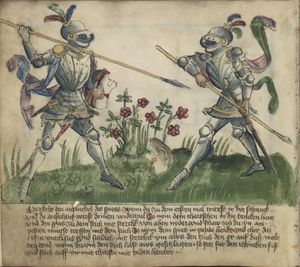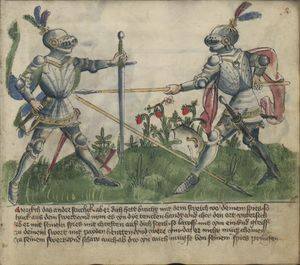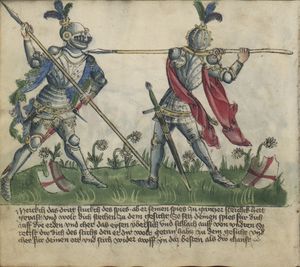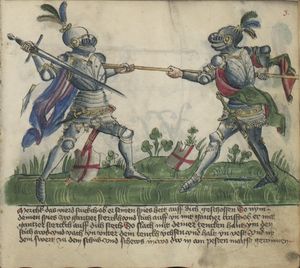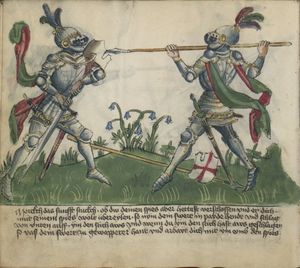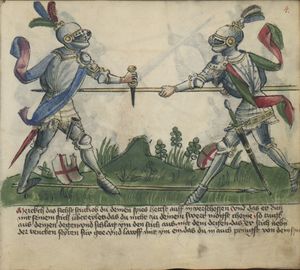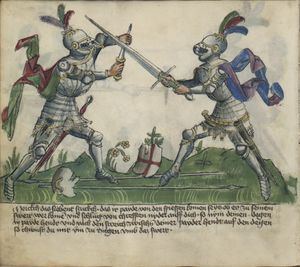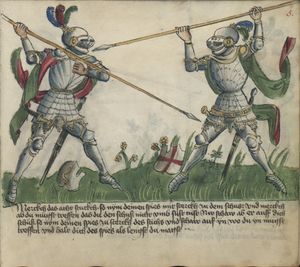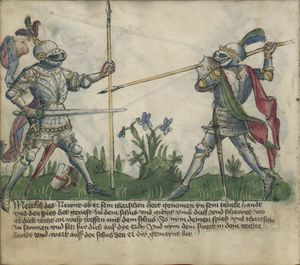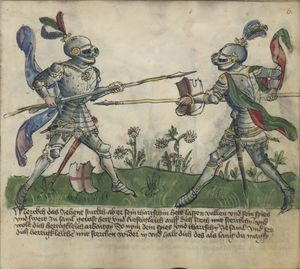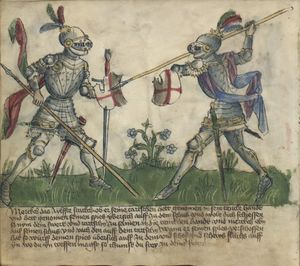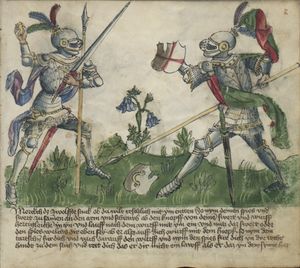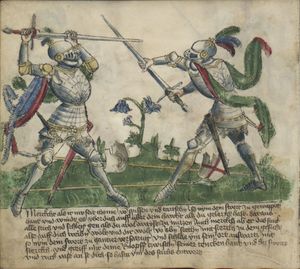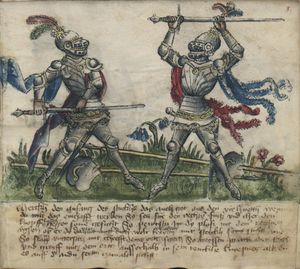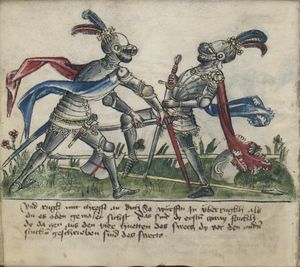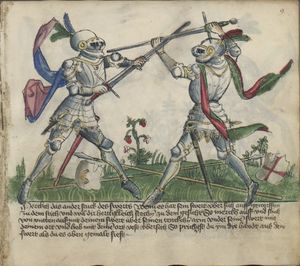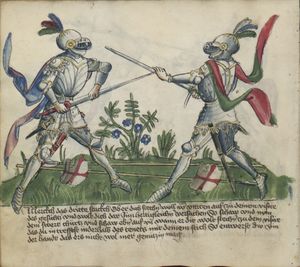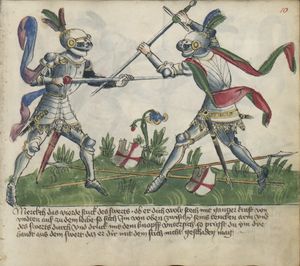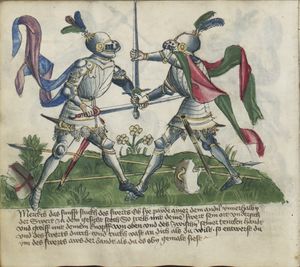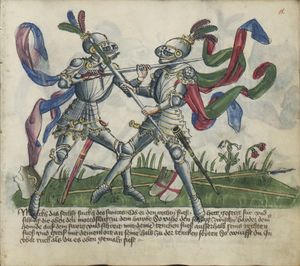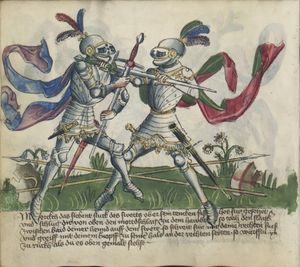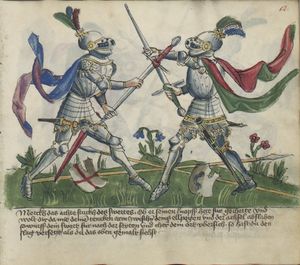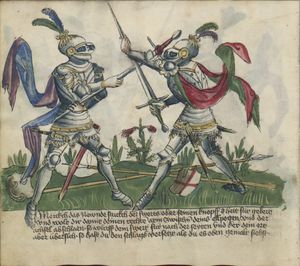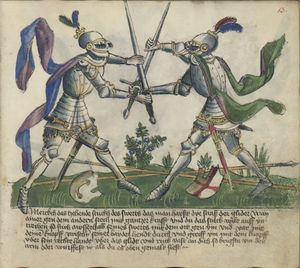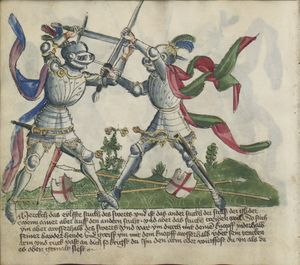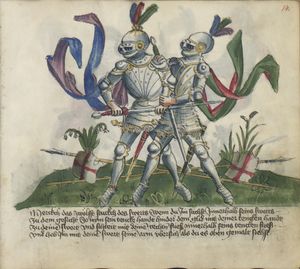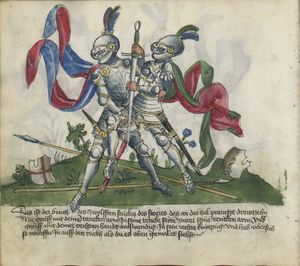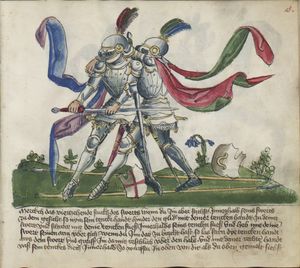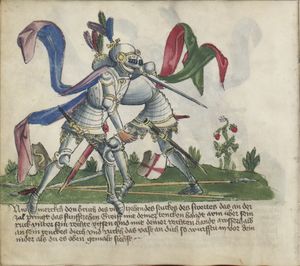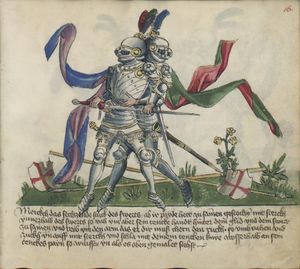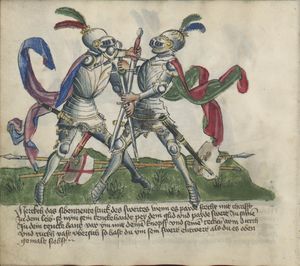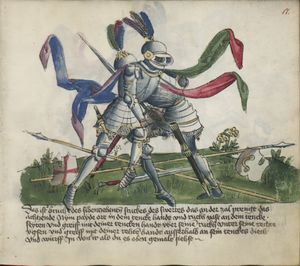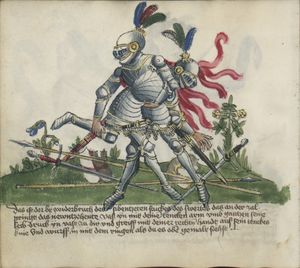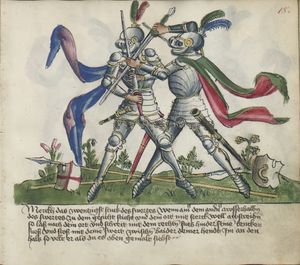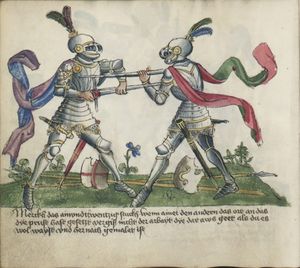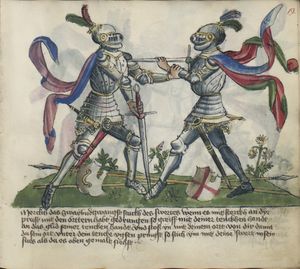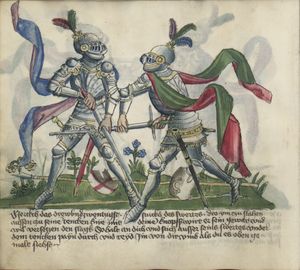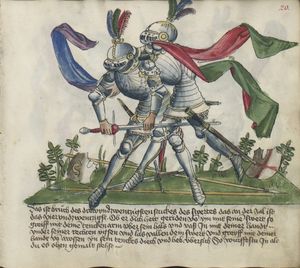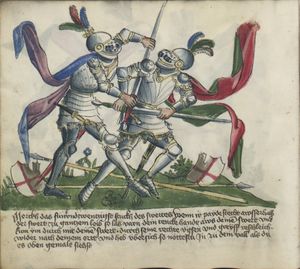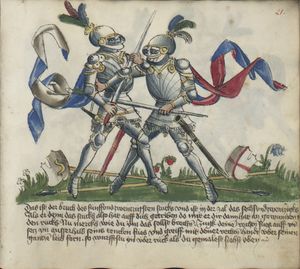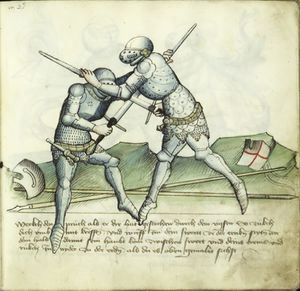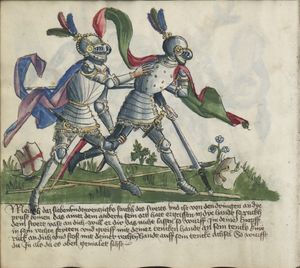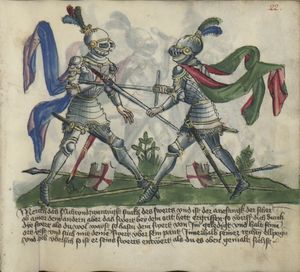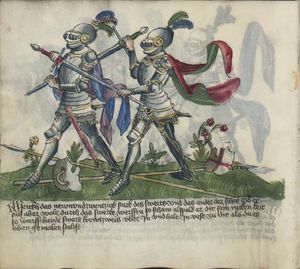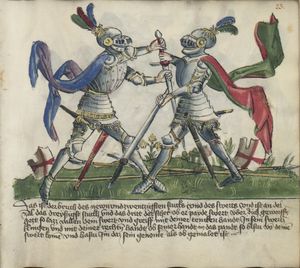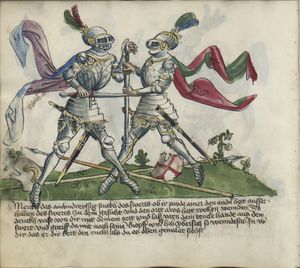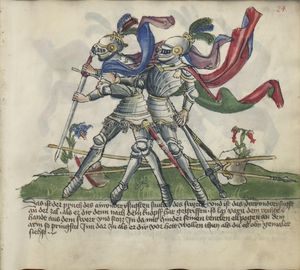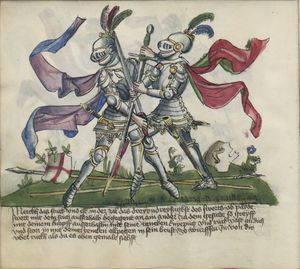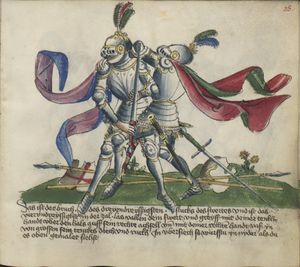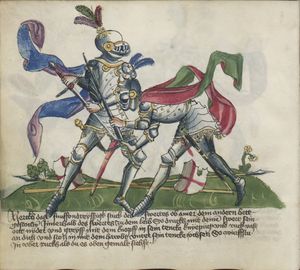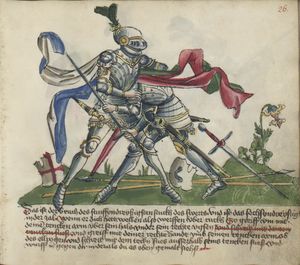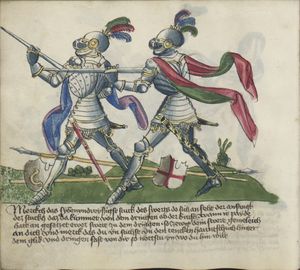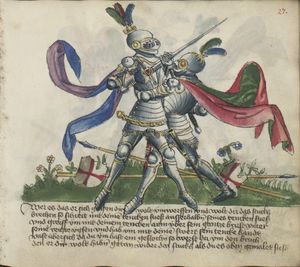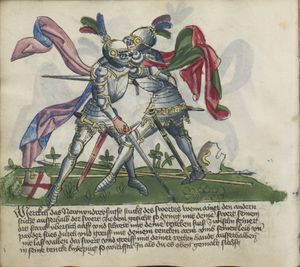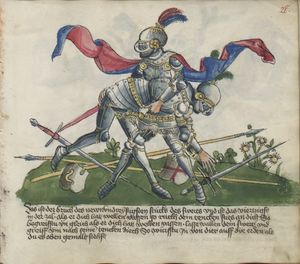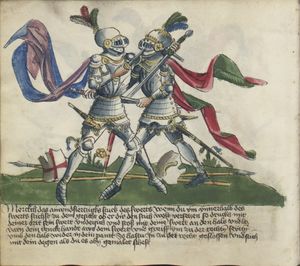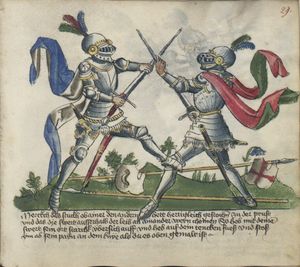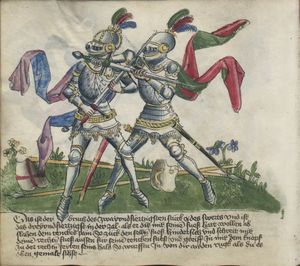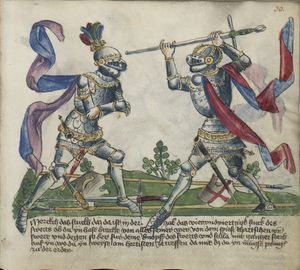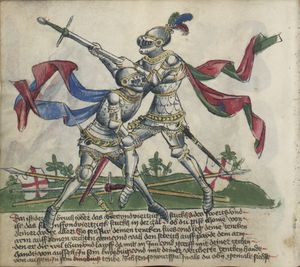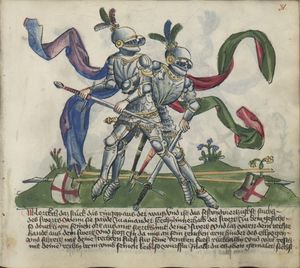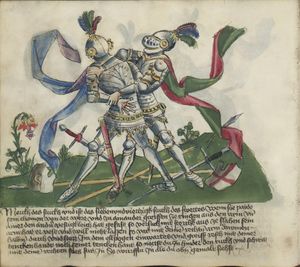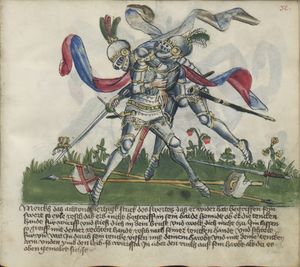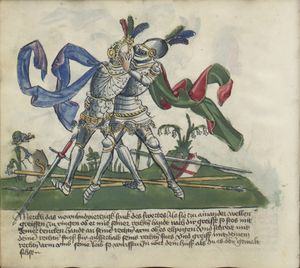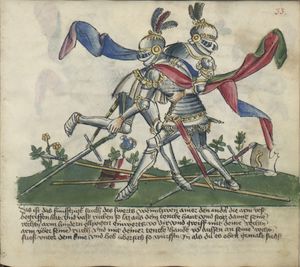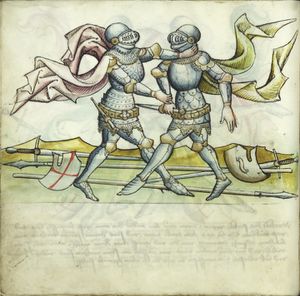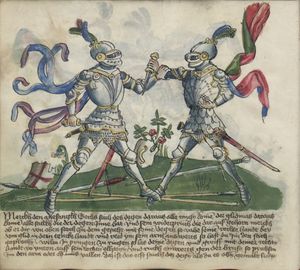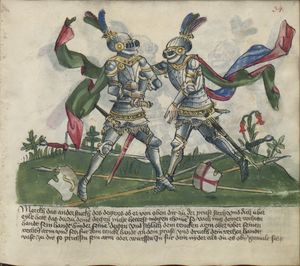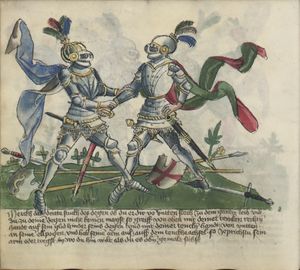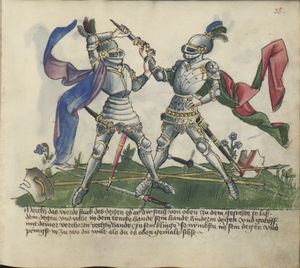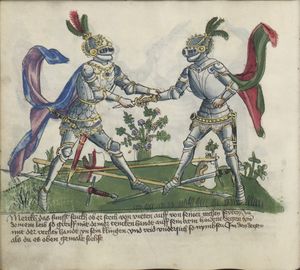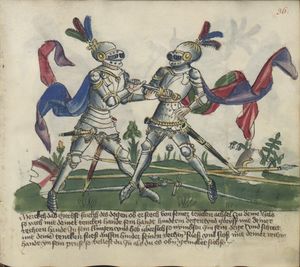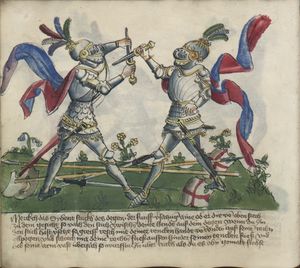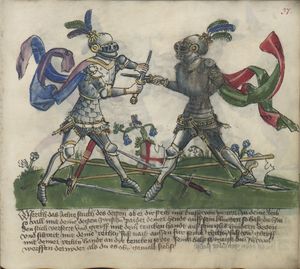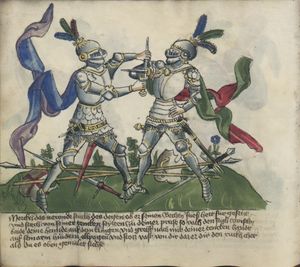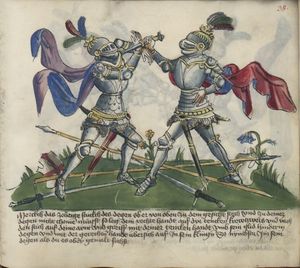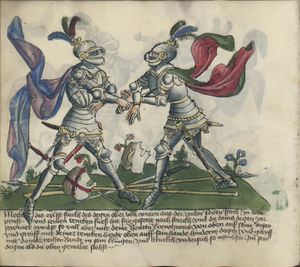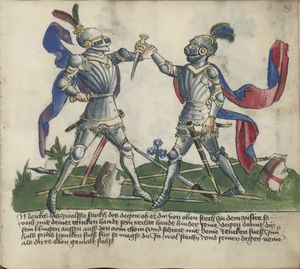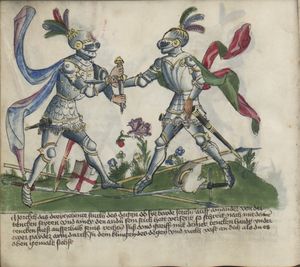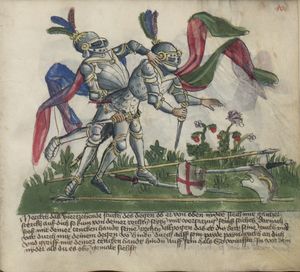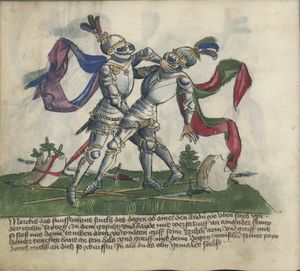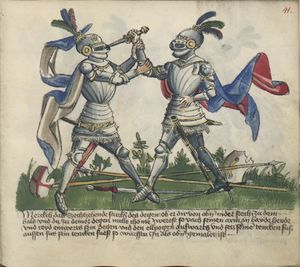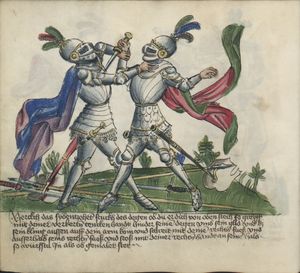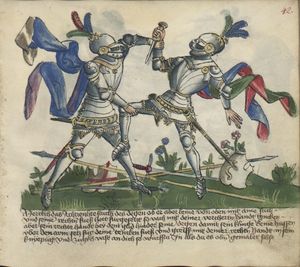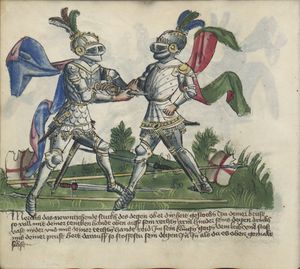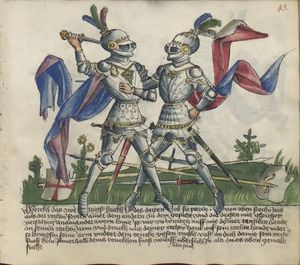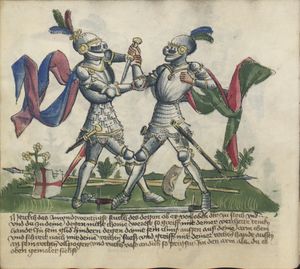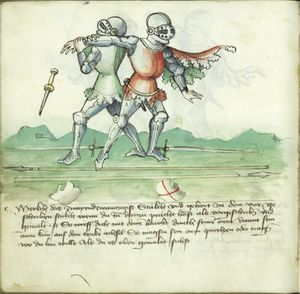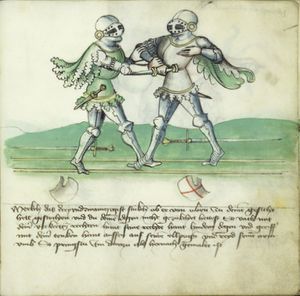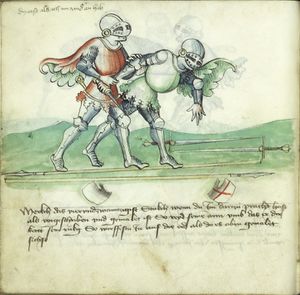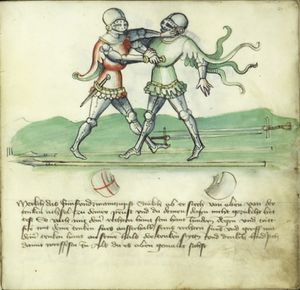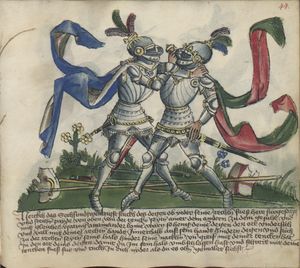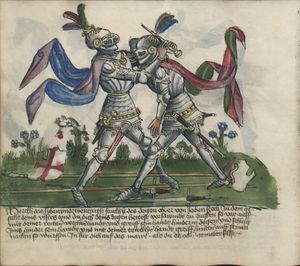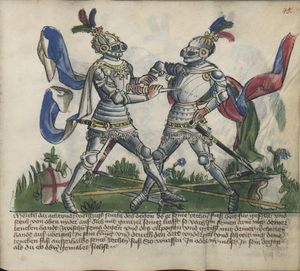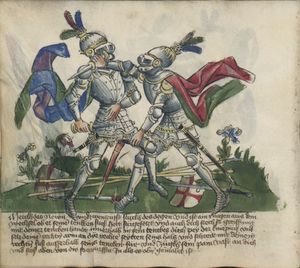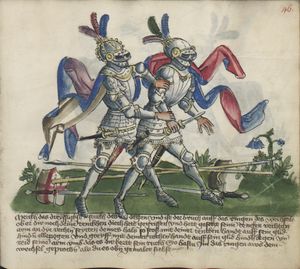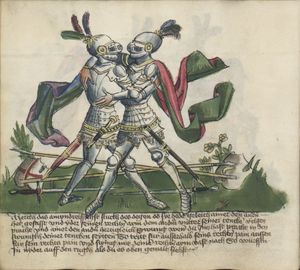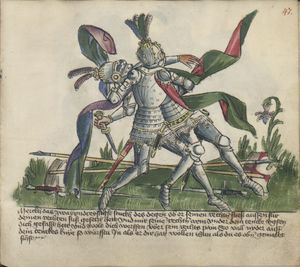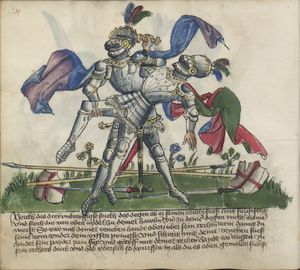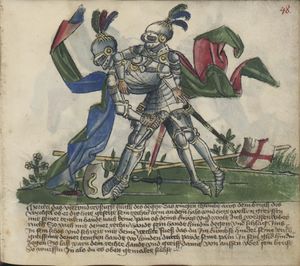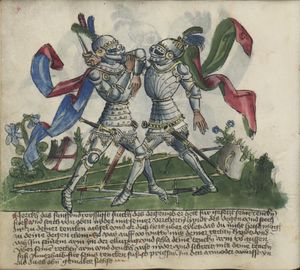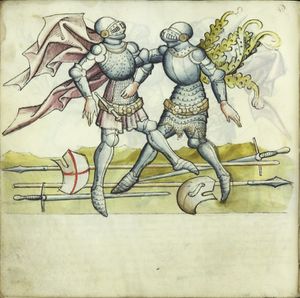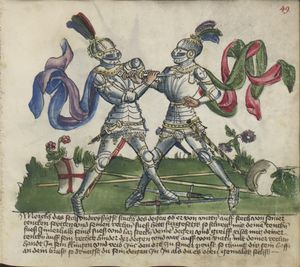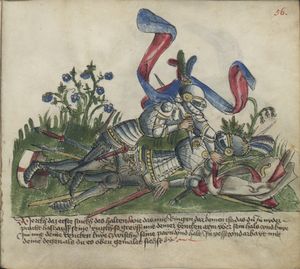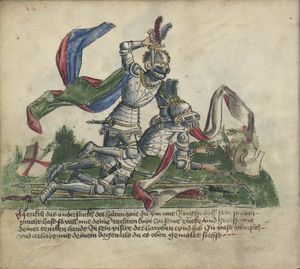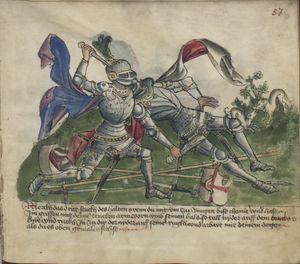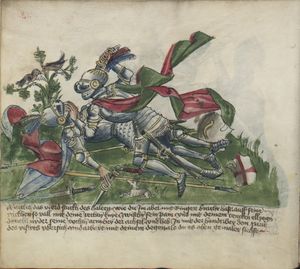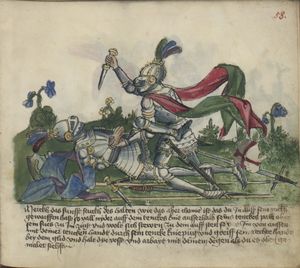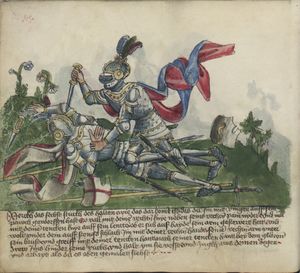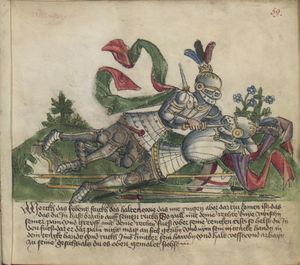|
|
You are not currently logged in. Are you accessing the unsecure (http) portal? Click here to switch to the secure portal. |
Difference between revisions of "Gladiatoria group"
m (The translation of 12th play in spear was incorrect. It doesn't say to "end someone rightly", The original says "reschlich" or "reschlach" which is another form of rischlich or rieschlich (etc.) meaning simply "quickly".) |
|||
| Line 59: | Line 59: | ||
== Treatise == | == Treatise == | ||
| − | Due to the fact that [[Wolfenbüttel Sketchbook (Cod.Guelf.78.2 Aug.2º)|Wolfenbüttel]] and [[Cluny Fechtbook (Cl. 23842)|Paris]] versions appear in a mixed anthologies combining multiple sources, only those images from the manuscripts that are reflected in at least one other version of Gladiatoria are included in the concordance below | + | Due to the fact that [[Wolfenbüttel Sketchbook (Cod.Guelf.78.2 Aug.2º)|Wolfenbüttel]] and [[Cluny Fechtbook (Cl. 23842)|Paris]] versions appear in a mixed anthologies combining multiple sources, only those images from the manuscripts that are reflected in at least one other version of Gladiatoria are included in the concordance below. |
{{master begin | {{master begin | ||
Revision as of 18:24, 11 July 2016
| Gladiatoria Group | |
|---|---|
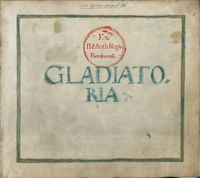
| |
| Author(s) | Unknown |
| Illustrated by | Unknown |
| Patron | Unknown |
| Date | ca. 1430s |
| Genre | |
| Language | Early New High German |
| Archetype(s) | Currently lost |
| Manuscript(s) |
MS U860.F46 1450 (1440s)
|
| First Printed English Edition |
Knight, 2008 |
| Concordance by | Michael Chidester and Dierk Hagedorn |
| Translations | Traduzione italiana |
The Gladiatoria Group is a series of several 15th century German manuscripts that share the same art style and cover the same material—various types of armored combat. These are interesting texts in that they seem to be contemporary with the tradition of Johannes Liechtenauer, but not directly influenced by it.[citation needed] Gladiatoria is thus one of very few glimpses into the characteristics of a potentially independent German martial tradition.
The core of the Gladiatoria group is a series of devices of armored fencing following the typical progression of a judicial duel: beginning with spears and small shields called ecranches, moving to longswords, then employing daggers on foot and on the ground. (Traditional dueling would begin on horseback before going to foot combat, and the ecranche is designed for mounted fencing, but Gladiatoria skips that stage entirely.) The diverse manuscripts in the group generally describe other kinds of fighting as well, such as the sword and buckler of the Codex Guelf 78.2 August 2º or the longshield of the MS German Quarto 16, but these teachings lack some of the common elements of the core Gladiatoria complex and will not be covered on this page. They may be found on the individual manuscript pages.
There are currently five known versions of the Gladiatoria treatise, found in the MS KK5013, the MS German Quarto 16 (the only version with a title page), the MS U860.F46 1450, the Codex Guelf 78.2 August 2º, and the MS Cl. 23842. Hans-Peter Hils mentions a sixth lost manuscript identified as MS T in his edition of Gladiatoria,[1] but Dierk Hagedorn has since determined that this is the MS U860 F46 1450 (which Hils did not have access to). Aside from these five, there are several other manuscripts that some scholars have ascribed to the group. These include the the Cod.11093 and part C of the Codex Wallerstein (also known as pseudo-Gladiatoria for this reason). In each case, there are disqualifying factors that lead us to exclude them from the group, but additional research may reverse these decisions.
While the three oldest texts in the Gladiatoria complex present a fairly identical set of devices, the slightly later Wolfenbüttel version of the treatise contains significantly more material, primarily in the dagger section. The origin of this additional material is unknown, and the textless nature of that version makes it difficult to place these plays in any sort of context.
Contents
Treatise
Due to the fact that Wolfenbüttel and Paris versions appear in a mixed anthologies combining multiple sources, only those images from the manuscripts that are reflected in at least one other version of Gladiatoria are included in the concordance below.
Images |
Vienna Transcription (1430s) |
Kraków Transcription (1435-1440) |
New Haven Transcription (1440s) |
Wolfenbüttel Transcription (1465-1480) |
Paris Transcription (1490s) | |
|---|---|---|---|---|---|---|
Note the first play of the spear. When you initially enter the barricades and see your opponent, hold your buckler in your left hand and raise your spear [with the right hand] for a powerful downward thrust and see where you might hit him easiest. Turn the spear with the iron towards the ground (lit: turn the iron below itself) and deflect the thrust he wanted to direct at you with a strong blow. And when you deflect his thrust, aim for his left foot and thrust with force, using both hands. |
[01v] Merckcht den anfanckch des spiess wenn du zu dem ersten mal tritest in dye schrenck - vnd du ansichtig wirst deinen widertail So nym dein thartschen in dye tencken hant vnd den spies zu dem stich mit sterchk von oben nyder . vnd schaw wo du yn am . pesten mügst treffen mit dem stich So nym dein spies in peyde hendt . vnd cher daz eysen vntersich .vnd schlach mit sterchck ym aws den stich den er auf dich wolt tun .vnd wenn du ym den stich hast aws geschlagen . so setz für den thencken fuß vnd stich auff yn mit chreften mit peden henten – |
[033r] [No text] |
||||
Note the second play of the spear. If he foiled the thrust of your spear, draw your sword and hold it in your left hand, point down, awaiting his powerful thrust. Close in, grip your sword with both hands and keep him from getting to his sword, and see if you can part him from his spear. |
[02r] Merckch das ander stuchck . ab er dich hett bracht mit dem streich von deinem spies . so tzuck aus dein swert . vnd nym es yn dye tencken handt . vnd cher den ort vntersich .ab er mit seinem spies mit chreften auf dich stech . so lawff mit ym ein . vnd greiff zu deinem swert mit payden hentten . vnd were ym . daz er nicht müg chomen zu seinem swert vnd schaw auch . ab dw yn auch mügst von seinem spies pringen – |
[035v] [No text] |
||||
Note the third play of the spear. If he grabs his spear with all his might and prepares for a thrust to your face, set your spear on the ground in front of you, point up, and deflect his thrust with an upward blow. This way you avert his thrust on your face. Now change your position (lit. "turn your place") and thrust at him as best as you can. |
[01v] Merkch das dritt stukch des Spýes ob er seinen spýes zw gantz[er] sterkch hyet gevasst vnd walt dich stech[e]n zw dem gesicht So setz[e] deinen spyes fürdich auff dy erd[e]n vnd cher das eys[e]n vbersich vnd slach auf vnder von úndt[e]n So retstw dich des stichs den er dir walt tan hab[e]n zw dem gesicht |
[02v] Merckch das dritt stuckch des spies . ab er seinen spies zu gantzer sterchck hett gevast vnd wolt dich stechen zu dem gesicht So setz deinen spies für dich . auff dye erden vnd cher das eysen vbersich vnd schlach auff von vndten So retzst dw dich des stichs den er dir wolt getan haben zu dem gesicht vnd cher für deinen ort vnd stich wider awff yn daz besten als dw chanst – |
[033v] [No text] |
|||
Note the fourth play. If he threw his spear at you, grip your spear with all your strength and thrust at him with all your power. If he thrusts at you with all his strength, deflect his blow with your left hand, put it under your left armpit and hold it there. Draw your sword and shoot it where you have the best chance of winning. |
[02r] Merkch das vyerd stukch ob er seinen sp:es hett auff dich geschass[e]n Sa nýmb deinen sp:es zw gantz[er] sterkch vnd stich auff in mit gantzer krafft ob er mit gantz[er] sterkch auff dich stech So slach mit dein[er] tenk[e]n hant ym den stich aus vnd vach yn únd[er] dein tenkes üseh[e]n vnd halt vest vnd ny[m] dein Swert zw dem schüs vnd schews in wo dw in am pest[e]n mügst gewomen[3] |
[03r] Merchk das vierd stuckch . ob er seinen spies hett auff dich geschossen So nym - deinen spies zw gantzer sterckh . vnd stich auff yn mit gantzer crafft . ob er mit gantzer sterckch auff dich stech . So slach mit deiner tencken hant . ym den stich aws . vnd vach yn vnter dein tenckh vchsen . vnd halt yn vest . vnd nym dein swert zu dem schüs . vnd schews in wo dw in am pesten magst gewinnen – |
[01r] Merckch das vyerd stuckch ober seinen spÿes hett auff dich geschossñ So nym deinen spÿes zw gantz krefft vnd stich auff in mit gantz krafft ob er mit gantz sterckch auff dich stech so slach mitt deiner tenkñ hant im den stich aus vnd vach in vnder dein tenkchs vschen vnd halt vest vnd nim dein swert zw dem schüs vnd schaus in wo dw in am pestñ mugst gewInnen |
[036r] [No text] |
||
Note the fifth play. If you threw your spear and missed and his counter-thrust comes too fast, grip your sword with both hands and deflect the thrust with an upwards strike. After deflecting, hold your sword in your armored hand and work it around his spear. |
[02v] Merkch das funfft stukch ob dw deinen spýes aber hentst v[er]schoß[e]n vnd er dich mit seinem spýes walt vbereyll[e]n So nymb dein swertt in pede hendt vnd slach von vntt[e]n auff ym aus denn[4] stich vndym den stich hast aus geslag[e]n So vas dein swert zw gwaptn[er] hant vnd aribait in in mit sterkch |
[03v] Merckch das funfft stuckch . ob dw deinen spies aber hettest verschossen vnd er dich - mit seinem spies wölt übereylen . so nym dein swert in payde hendt vnd schlag von vnten auff . ym den stich aws vnd wenn du ym den stich hast aws geschlagen so vaß dein swert zu gewappeter hant vnd arbayt dich mit ym vmb den spies . |
[01v] Merkch das funfft stukch ob dw deinen spÿes aber hetest v°schossñ vnd er dich mit seinem spyes wolt vbereyllñ So nymb dein swertt in pede hentt vnd slach von vntten auff ym aus den stich vnd ym hast den stich ausgeslagñ So vas dein swertt zw gewapptñ hant vnd aribait in yn mit sterkch |
[036v] [No text] |
||
Note the sixth play. If you threw your spear at him and missed, and his counter-thrust comes too fast for you to get to your sword, draw your dagger and deflect his thrust so it passes your left side. Now close in on him and try to part him from his spear. |
[03r] Merkch das sechst stukch ab dw deinen spýes hettst auff in v[er]schass[e]n vnd das er dich mit seinem stich vber eyllett das dw nicht mit zw deinem swert machst komen So zukch[5] aus deinen deg[e]n vnd slach ym den stich aus mit dem deg[e]n das der stich neben der tenk[e]n seyt[e]n für gee vnd lauff mit ym ein das dw in auch pringst von dem spýes |
[04r] Merckch das sechst stuck . ob du deinen spies hettst auff in verschossen . vnd das er dich mit seinem stich über eylet . das du nicht zu deinem swert mögst chomen . so tzugk aus deinen degen . vnd schlag ym den stich aus . mit dem degen . das der stich neben der tencken seyten für gee . vnd lawff mit ym ein . das du in auch pringst von dem spie[s][6] |
[02r] Merkch das Sechst stukch ob dw deinen spyes hetst auf in v°schossñ vnd das er dich mit seinem stich vber eyllett das dw nicht zw deinem swertt machst kömen So czukch aus deinen degenn vnd slach ym den tisch/risch aus mit dem degenn das der stich neben der tenkñ seyttn für gee vnd lauff mit ym ain das dw in auch pringst von dem spyes |
[079v] [No text] (Image contains an error) |
||
Note the seventh play. If you have successfully parted him from his spear and he draws his sword and strikes at you, grab the dagger in both hands and catch his blow between your hands with the dagger. This way, you can start wrestling for his sword. |
[03v] Merkch das Sub[e]nt stukch das ir ped van den spyess[e]n kämen[7] seýt ob er zw seinem swert wér kämen vnd slüeg van krefft[e]n nyd[er] auff dich So ny[m] deinen degenn in pede hent So vach den straich zwisch[e]n dein[er] peder hent auff den deg[e]n So kümst dw mit ým zw ring[e]n vmb das swert |
[04v] Merckch das siebent stuckch . das ir payde von den spiessen komen seyt . ob er zu seinem swert wer komen vnd schlüg von chrefften nyder auff dich . so nym deinen . Degen in payde hendt vnd vach den streich zwischen deiner payder hendt auf den degen so chümst du mit ym zu ringen vmb daz swert – |
[02v] Merkch das Sübnt stukch das ir pã von den spyessñ komen seÿtt ob er zw seinem swert wer kömen vnd slüg von krefftn nyder auff dich So nÿmb deinn degenn in pede hentt So vach den straich zwischñ dein° peder hentt auff den degen So kumst dw mit ym zw ringñ vmb das swertt |
[080r] [No text] |
||
Note the eighth play. Grab you spear for a powerful throw and decide whether you might hit him, to not throw your spear in vain. If he throws at you first, prepare to thrust your spear at him and see where you might hit him. Keep at this play as long as you can. |
[04r] Merkch das acht stukch So nymb deinen spýes mit sterk[e]n zw dem schusz[e] vnd merkch ob dw mügest treff[e]n das dw den schuss nicht vmb sunst tüst nw schaw ab er auff dich schüss So nym deinen spyes zw sterkch des spyes stich vnd schaw auff yn wo dw mügest recht[8] treff[e]n vnd halt dich des spýes als lenginst das dw machst |
[05r] Merckch das acht stuckch . so nym deinen spies mit sterckh zu dem schusz vnd merckch ab du mügst treffen das du den schuß nicht vmb sust tüst Nw schaw ab er auff dich schüß . so nym deinen spies zu sterckh des stichs vnd schaw auf yn wo du yn mügst treffen vnd halt dich des spies als lengst du magst – |
[03r] [The text at the bottom of the page has been cut off below the feet of the two fighters.] |
[032r] [No text] |
||
Note the ninth. When he holds his buckler in his left hand, raised his spear for throwing and is now looking where he might best hit you, put your spear and buckler together and place your spear on the ground in front of you. Draw your sword with your right hand and wait for his throw. |
[04v] Merkch das Newnt ob er sein tatsch[e]n hett genamen in sein tenkche hant vnd den sp:es hett gevast zw dem schüss vnd gieng vmb dich vnd schawet wo er dich recht an walt treff[e]n mit dem schüss So nymb setz[e] deinen spýes vnd tatsch[e]n zw sammen vnd setz[e] für dich auff dy erd nym dein swert in dein recht hant vnd wart auff den schüss den er dir gemaynt hat |
[05v] Merckch das Newnt . ob er sein tharschen hett genomen yn sein tencke handt vnd den spies het gevast zu dem schus vnd gieng vmb dich vnd schawet wo er dich recht an welt treffen mit dem schus So nym deinen spies vnd thartschen zu sammen vnd setz für dich auf dye erden Vnd nym dein swert in dein rechte handt vnd wart auff den schus den er dir gemaynt hat |
[03v] [The text at the bottom of the page has been cut off below the feet of the two fighters.] |
[037r] [No text] |
||
Note the tenth play. If he dropped his buckler and is holding his spear and sword together and thrusts at you with strength and wants to work you vigorously, hold your spear and your buckler together and vigorously resist him for as long as you can. |
[05r] Merkch das zehent ab er sein tatsch[e]n hett lass[e]n vallen[9] vnd sein spyes vnd swert zw samb gevast hett vnd krefftikleich auff dich stech mit sterkch vnd walt dich herttikchleich[e]n aribaitt[e]n So nymb dein spýs vnd tatsch[e]n zesamb vnd setz[e] dich hertikchleich[e]n mit sterkch wider in vnd halt dich des als lengist dw machst |
[06r] Merckch das zehent stuckch . ab er sein thartschin hett lassen vallen vnd sein spies vnd swert zu sam[en] gevast hett vnd kreftigleich auff dich stech mit sterckchen vnd wolt dich hertigkleich arbaiten So nym dein spies vnd thartschen ze sam[en] vnd setz dich hertigkleichen mit stercken wider in vnd halt dich des als lang du magst |
[04r] [The text at the bottom of the page has been cut off below the feet of the two fighters.] |
[034v] [No text] |
||
Note the eleventh play. When he holds his buckler in his left hand and raised his spear above his head, ready to throw, and wants to throw it at you, put your sword and buckler together in your left hand and watch out for his throw. Catch it with your buckler, raise your spear above your head and throw it swiftly at where you might hit him. This way you are free to get at your sword. |
[05v] Merkch das Aindlefft ob er seine tatsch[e]n hett genamen[n] in sein tenke hant vnd het genamen seinen spýes vbersich auff zw dem schüss vnd walt dich schieß[e]n So nýmb dein swert vnd tasch[e]n zw samb in dýe tenkch hant vnd merkch eb[e]n auff seinen schüs vnd vach den auff dein tatsch[e]n wann er seinen spýes v[er] schass[e]n hat so wirff deinen spyes vbersich auff zw dem schös vnd scheus fluchs auf in wa dw in treff[e]n kanst So kümst dw freý zw deinem swert |
[06v] Merckch das Aylffte stuckch . ob er seine tartschen hett genomen in sein tencke handt vnd hett genomen seinen spies vbersich auff zu dem schus vnd wolt dich schiessen so nym dein swert vnd tartschen zu sammen in dye tenckhen handt vnd merckch eben auf seinen schus vnd vach den auff dein tartschen wann er seinen spies verschossen hat so würff deinen spies übersich auff zu dem vnd schosz vnd schews flüchs auff yn wo du yn treffen magst so chumst du frey zu deinem swert – |
[04v] [The text at the bottom of the page has been cut off below the feet of the two fighters.] |
[032v] [No text] |
||
Note the twelfth play. If you want to end him quickly, hold your spear and sword together on your arm, unscrew the pommel of your sword and throw it at him vigorously. Close in with the throw and use your sword or spear, whatever suits you best. When he throws his pommel at you, keep your buckler close to you and watch out for the throw. Hold your spear in your right hand and prepare to thrust, to stop him from closing in if it is his intention. |
[06r] MMerkch das zwelifft[10] ab dw wildt reschlach mit ym entt[e]n So nymb deinen spýes vnd swert zw samb an den arm[e] vnd schraw ab den knoph von deinem swert vnd wirff hertikchleich[e]n in in vnd lauff nach dem würff mit im ein vnd nütz[e] swert ader spýes welichs dir eb[e]n sey ab er also auff dich würff mit dem knoph So nym dein tatsch[e]n für dich vnd vach darauff den würff vnd nym den spyes für dich in dye richt hant zw dem stich vnd rett dich s[ei]n[11] das er dir nicht ein lauff als ers in dem synne hatt |
[07r] Merckch daz zwolffte stuck ob du wilt reschlich mit ym entten So nym deinen spies vnd swert zu sammen an den arm vnd schrawb ab den knopff von deinem swert vnd würff hertigleichen in yn vnd lauff nach dem wurff mit ym ein vnd nütz daz swert oder den spies welchs dir eben sey . ab er also auff dich würff mit dem knopf . so nym dein tartschen für dich vnd vach darauff den wurff vnd nym den spies für dich yn dye recht handt zu dem stich vnd rett dich das er dir nicht einlawff als er daz yn dem synne hat |
[05r] Merkch das zwelifft ob dw wildt reschleich mit ym entten So nymb deinen spye[s][12] vnd swert zw samb an den arm vnd schrawff ab den knöph von deinem swertt vnd wirff hertikchleichñ in in vnd lauff nach dem würff mit ym ein vnd [nym?] swert oder spyes welichs dir ebñ sey ob er also auff dich wurff mit dem knopph So nym dein taschn fur dich vnd vach darauff den wurff vnd nym den spyes für dich in die recht hant zw dem stich vnd rett dich sein das er dir nicht im lauff als er[13] |
[035r] [No text] |
Images |
Vienna Transcription (1430s) |
Kraków Transcription (1435-1440) |
New Haven Transcription (1440s) |
Wolfenbüttel Transcription (1465-1480) |
Paris Transcription (1490s) | |
|---|---|---|---|---|---|---|
Note that now you have lost spears and shields: Take your sword at the armor-hand and wind it above your head as you have learned; this position leads to all the thrusts and strikes as you well know how to do them. Also, note if he wants to execute the technique against you and thrust from above strongly into your face, then take your sword for the full displacement and strike out his point with strength, and catch with your pommel in between his left hand and the sword and jerk hard towards you--thus you have warded off his thrust. |
[06v] Merkch den anefang des kurtzen swerts vnd wenn du in die Schrenkenn bist kömen zu deine[m] veyntt vnd du alle dein wér beyeinander hast Spies tartz[e]n vnd Swertt vnd auch deine[n] deg[e]n , vnd das du deine[n] Spies v[er]schossen hast vnd von dein[er] tartz[e]n köme[n] bist So nymb dein Swert zu gewappent[er] hant als du es gelernt hast vnd wint es übersich vber dein haubt zu dem Stich von oben als du es oben gemalet sichst |
[07v] Merckcht als ir nw seit chomen von spissen vnd tartschen . so nym dein swert zu gewappet[er] hant vnd windt es vberdich auff über dein hawbt als du gelernt hast . daraus - alle stich vnd schleg gen als du wol wayst zu nützen Auch merckch ab er das stuck also auff dich treiben wölt vnd dir wölt von oben stechen mit sterckh zu dem gesicht so nym dein swert zu gantzer versatzung vnd schlae ym seinen ort auswartz mit sterckch . vnd greiff mit deinem knopff tzwischen seiner tencken hant vnd dez swerts vnd ruck vast an dich[14] . so hastu ym des stichs entwert |
[05v] Merkch den anefankch des kurczn swertt vnd wenn dw in die schrenkchn bist kom[en] [z]w[15] deinem veint vnd dw alle dein wer peyeinand° hast Spies taschñ vnd swert vnd auch deinen degñ vnd das dw deinen spyes v°schossñ hast vnd von deiñ taschñ komen bist So nymb dein swertt zw gewapptñ hantt als dw es gelernt hast vnd wint es vbersich vber dein haupp zw dem stich von obñ als dw es obñ gemalt siechst |
[041r] [No text] |
||
Note the beginning of the technique that also derives from the four guards: When you want to do this seriously move your right foot forward and turn your pommel forward towards his face, thus you offer him an opening at your right armpit. If he means to seek or exploit your opening with a strong thrust then strike down with strength with your sword’s point. So you displace his thrust, and grab with the point from the outside in his left hollow of knee like you see it in the next picture. [Continued] |
[08r] Merckh den anfang des stuckhs das auch get aus den vir huetten wenn du wilt das enthafft treyben So setz für den rechten füesz vnd cher den knopfffur sichgegen seinem gesicht So pewtstu Im dy plosz mit deinem rechten vgsen ob er dy plozdamit auff dich wolt traybenoder suchenmit sterckh seins stichs vnd So slagch vnttersich mit chrefft deins ortt swertz So weysstu Im aus den stich vnd greyff mit dem ortt ausserhalb in sein tenckhe knyepueg als du es auff der andern seytten gemalt sichst |
[068v] [No text] |
||||
[Continued] And pull powerfully towards you so you can throw him on his back as you see it in the picture above. These are the first two techniques deriving from the four guards of the sword that are described before the other sword techniques. |
[08v] Vnd rugk mit chrefft an dich So würfstu In vberrugkh als du es oben gemalet sichst Das sind dy ersten tzway stuckh dy da gen aus den vier huetten des swertz dy vor den andern stucken geschrieben sind des swerts |
[069v] [No text] |
||||
Note the second technique of the sword: If he has brought his sword over his head ready for the thrust and means to thrust vigorously towards your face then get ready and thrust from below with the point of your sword over his left arm and underneath his sword and pull your point powerfully upward so that his hand comes off his sword like you see it in the picture above. |
[07r] Merkch das stukch wenn er hat sein swert vber sich auff gewarff[e]n zw dem stich vnd wil dir hertikchleich[e]n stch[e]n zw dem gesicht So merkch auff vnd stich von vntt[e]n auff mit deinem swert vber seinen tenkch[e]n arm[e] vnder sein swertt mit deinem ärtt[16] vnd heb mit deinem art vest vbersich So prichst ym dy handt aus dem swert als dws gemalet sichst |
[09r] Merckch das ander stuck des swerts Wenn er hat sein swert vber sich auff geworffen zu dem stich vnd wil dir hertigkleich stechen zu dem gesicht So merckh auff vnd stich von vntten auf mit deinem swert über seinen tenckchen arm vnder seinem swert mit deinem ort vnd heb mit deinem ort vest vbersich So prichgst du ym dye handt aus dem swert als du es oben gemalt siest – |
[06r] Merkch das stukch wenn er hatt sein swert vbersich auff geworffn zw dem Stich vnd wil dir herttikchleichn stechñ zw dem gesicht So merkch auf vnd stich von vnttñ auff mit deinem swertt vber seinen tenkn arm vnd° sein swertt mit deinem ortt vnd heb mit deinem ortt vest vbersich So prichst ym dÿ hantt ausdem swertt als dws gemalt siechst |
[044v] [No text] |
||
Note the third technique: If he wants to stab from below towards your visor and means to seek you here vigorously, then look and take your sword close [short?].[17] And just when he means to thrust at your visor, see that you hit him inside on his palm with your thrust thus you deprive him of his hand so that he cannot use it any more. |
[07v] Ob er dir stekh von vntt[e]n auff zw deinem visïr[18] des gesichst vnd wolt dich darhin[19] herttikchleich[e]n versüch[e]n So schaw vnd nym dein swert chürtz[e] vnd schaw eb[e]n auff in wenn er dir walt stech[e]n zw dem vysier das dw in trefst inderhalb des terrss mit deinem stich So enttwerst dw ym der hant das ers nicht wolmer genütz[e]n[en] mag |
[09v] Merckch das dritte stuckch / Ob er dich stechen wöll von vntten auf zu deinem visire des gesichtz vnd wolt dich dar Inn hertigleichen versuchen So schaw vnd nym dein swert chürtz vnd schaw eben auf yn wann er dir wolt stechen zu dem visire das du in treffest inderhalb des teners mit deinem stich So entwerst dw ym der handt das ers nicht wol mer genützin mag . |
[06v] Ob er dir stech von vnttn auff zw de[inem][20] visyer des gesichst vnd wolt dich darIn herttikchleichn v°suechñ So schaw vnd nymb dein swertt churcz vnd schaw ebñ auff in wenn er dir wolt stechn zw dem visyer des dw in trefst inderhalb des Tenrss mit deinem stich So enttwerst dw ym der hant das ers nicht wol mer mag genüczn |
[045v] [No text] |
[195r] [Impressed in paper with drypoint:] [Normal ink:] | |
Note the fourth technique with the sword: If he wants to thrust with full power at your body from below then thrust from above in between his left arm and his sword and push down with the pommel so that his hand comes off his sword and he cannot harm you with his thrust. |
[08r] Ob er dir stăch mit gantzĕr kraft von vnd[e]n auf zu dem leib So stich Im von ob[e]n zwischen seins tenk[e]n arm vnd swertt durch vnd heb vbersich mit den knopff als du es oben gemalt sichst |
[10r] Merckch das vierde stuck des swerts . ob er dich wolt stech[en] mit gantzer kraft von vndten auf zu dem leibe . so stich Im von oben zwischen seins tencken arm vnd des swerts durch vnd druck mit dem knopff vntersich so prigst du ym dye handt aus dem swert daz er dir mit dem stich nicht geschaden mag – |
[08r] Ob er dir stich mit gancz krafft von vndñ auff zw dem leib So stich ym von oben zwischn seins tenkchn arm vnd swert durch vnd heb vbersich mit den knopff als dw es obenn gemalt siechst |
[041v] [No text] (Similar) |
[195v] | |
Note the fifth technique of the sword: If you both try to thrust inside each others’ swords at each others’ faces then push the point of his sword down with your sword and catch with your pommel from above in between his left hand and the sword and jerk towards you so that you take his sword from his hand as you see it in the picture above. |
[08v] Ob sy baid ain[er] dem and[er]n ynnerhalb der Swĕrtt zu dem gesicht stäch[e] So treib mit deine[m] Swĕrtt sein ort vndersich vnd greiff mit deine[m] knopff , von oben zwisch[e]n sein[er] tenk[e]n hant vnd Swĕrt durch vnd zükch vast an dich als du es oben gemalt sichst |
[10v] Merckh das sechst stuckh des swerts Ob er den rechten fueß . hett gesetzt für vnd schlug dir oben den mortdslag zu dem hawbt So vahe den schlag zwischen bayder deiner hennde auf dem swert vnd schreit mit deinem tencken fueß ausserhalb seins rechten fueß vnd greif mit deinem ort an seinen hals zu der tencken seyten So würfst du In vber ruck als du es oben gemalt siest – |
[046r] [No text] |
[196r] | ||
Note the sixth technique of the sword: If he has set his right foot and has struck the Mortdschlag to your head, then catch the strike with your sword in between your hands and step with your left foot outside of his right foot and catch with your point at the left side of his neck so you can throw him onto his back as you see it in the picture above. |
[09r] Ob er den Rechten fües het für gesetztt vnd slŭeg dir oben den mordslag zu dem haubt So vach den slag zwischen baider dein[er] hennd auf dem Swertt vnd schrayt mit deine[m] tenk[e]n fues ausserhalb seins Recht[e]n fues vnd greif mit deine[m] ort an seine[n] hals zu der tenk[e]n seytt[e]n So wirffestu Im über rükch als du es oben gemalt sichst - |
[11r] Merckh das sechst stuckh des swerts Ob er den rechten fueß . hett gesetzt für vnd schlug dir oben den mortdslag zu dem hawbt So vahe den schlag zwischen bayder deiner hennde auf dem swert vnd schreit mit deinem tencken fueß ausserhalb seins rechten fueß vnd greif mit deinem ort an seinen hals zu der tencken seyten So würfst du In vber ruck als du es oben gemalt siest – |
[09r] Ob er den Rechtten fües hett für gesecztt vnd slüeg dir obn den mordslag zw dem haubtt So vach den slach zwischn bayder deiner henndt auf dein Swertt vnd schraÿtt mit deinem tenckn fues ausserhalb seins Rechttn fües vnd greyff mit deinem ortt an seinen hals zw der tenkñ seyttñ So wirffestu ym vber rukch als dw es obñ gemalt siechst |
[047r] [No text] |
[196v] | |
Note the seventh technique of the sword: If he has set his left foot forward and tried to do the Mortdschlag to your head then catch the strike on your sword in between your hands and stride your right foot forward and catch with your pommel at the right side of his neck so you can throw him onto his back as you see it in the picture above. |
[09v] Ob er sein tenken fues het fŭrgesetztt vnd slüg dir von oben den mordslag zu den haubt So vah den slag zwischen baid dein[er] hennd auf dem Swert So schraytt für mit deine[m] Rechten fues ausserhalb seins tenk[e]n fuess vnd greyff mit deine[m] knopf zu seine[m] hals an der rechten seytt[e]n So wirffestu Im zü rükch als du es oben gemalt sichst |
[11v] Merckch das siebent stuck des swerts ob er sein tencken fuß het für gesetzet vnd schlüg dir von oben den mortdschlag zu dem hawbt so vah den slagk zwischen baid deiner hennd auff dein swert so schreit für mit deinem rechten fueß vnd greiff mit deinem knopff zu seinem hals an der rechten seyten . so würfstu yn zuruckh als du es oben gemalt siehst – |
[09v] Ob er seynn tenkñ fües hett fürgesecztt vnd slueg dir von obn den mordslag zw dem hawpph So vach den slag zwischñ bayd dein° hennde auff dein Swertt So schraÿtt für mit deinem rechtñ fues ausserhalb seins tenkñ fues vnd greyff mit deinem knopph zw seinem hals an der rechtñ seyttñ So wirffestu ÿm zw [ru]kch als dw es obn gemalt siechst |
[046v] [No text] |
[197r] | |
Note the eighth technique of the sword: If he has turned his pommel forward and wants to hit your left arm with it between elbow and shoulder then throw your sword forward to the side and turn your point up. Thus you have displaced the strike as you see it in the picture above. |
[10r] Ob er seinen knopf hett für gekertt vnd wolt dir damit deine[n] tenk[e]n arm zwisch[e]n deins ellpog[e]n vnd der achsel abslahen So wirff dein Swertt für nach der seytt[e]n vnd kër dein ortt vbersich So hastu den slag v[er]setzt , als du das oben ge malt sichst |
[12r] Merckh das achte stuckh des swertes . Ob er seinen knopff hett fur gecherte vnd wolt dir da mit deinen tenken arm zwischen deins ellpogen vnd der achsel abslahen so wurff dein swert fur nach der seyten vnd cher[e] dein ort vbersich . so hast du den slag versetzt als du das oben gemalt siehst |
[10r] Ob er seinen knopph hyett für gechertt vnd wolt dir damitt deinen tenkñ arm zwischñ deins ellpogñ vnd der achsell ab slachn So wirff dein swert für nach der seyttñ vnd ker dein ortt vbersich So hastu den slag v°seczt als dw das obñ gemalt siechst |
[048r] [No text] |
[197v] | |
Note the ninth technique of the sword: When he has turned his pommel forward and wants to hit your right arm between elbow and shoulder then throw your sword forward sideways and turn your sword’s point up. Thus you have displaced his strike as you see in the picture. |
[10v] Ob er seinen knopf het fŭrgekertt vnd wolt dir damit deine[n] rechten arm zwisch[e]n deins ellpog[e]n vnd der achsel abslahen So wirff dein swertt für , nach der seyt[e]n vnd kér dein ortt aber úbersich So hastu den slag v[er]setzt , als du es oben gemalt sichst - |
[12v] Merckch das newnde stuckch dez swerts ob er seinen knopff d hett für gekert vnd wolt dir damit deinen rechten arm zwischen deins ellpogen vnd der achsel abschlaen . so würff dein swert für nach der seyten vnd ker dein ort aber übersich . so hast du den schlagk versetzt als du es oben gemalt siehst – |
[10v] Ob er hett seinen knopph für gekertt vnd wolt dir damitt deinen rechtñ arm zwischñ deins ellpogens vnd der achsell ab slachñ So wirff dein swert für nach der seyttñ vnd ker dein ortt aber vbersich So hastu den slag v°secztt als dw es obñ gemalt siechst |
[047v] [No text] |
[198r] | |
Note the tenth technique of the sword which is called straß der glider:[22] When one thrusts with full power and wants to drive the technique on the other then thrust your point towards the outside of his sword and drive through between his hands with your pommel and catch onto his right wrist and jerk towards you so that you break his arm or throw him as you see it in the picture above. |
[11r] Merck daz stuck daz ma[n] heiszet die strasz der glider wan[n] einer gen den ander[e]n stech mit gantzer krafft vnd du daz stuck wilt vf Jn treben . So stich auszerhalb seines swertz mit dem ort gen Jm vnd var mit deine[m] knopf zwischen seiner beider hend durch vnd greif Jm mit dem knopf vber sein rechte hant vber daz glid vnd ruck vast an dich So brichst Jm den arm[e] oder wirfest Jn als du es oben gemalet sichst / |
[13r] Merckch das tzehende stuckh des swerts das man hayßt dye straß der glider wann ainer gen dem andern stech mit gantzer krafft vnd du das stück wilt auff yn treiben so stich awsserhalb seines swerts mit dem ort gen ym vnd var mit deinem knopff zwischen seiner bayder hendt durch vnd greiff ym mit dem knopff vber sein rechte handt vber das glidt vnd ruck vast an dich so brigstu ym den arm oder würffest in als du es oben gemalt siest – |
[07r] [The text at the bottom of the page has been cut off below the feet of the two fighters.] |
[069r] [No text] |
[198v] | |
Note the eleventh technique of the sword which is the second part of the straß der glider: When one thrusts at the other and wants to drive the technique then thrust him at the outside of his sword and drive through between his hands with your pommel and hook him with the pommel at the outside of his upper left arm and pull quickly towards you so that you break his arm or throw him as you see in the picture above. |
[11v] Merckch daz ander stuckch der strasz der glider wan[n] ein[er] aber den[n] vff den ander[e]n stech vnd aber daz stuckch treiben wil / So stich Jm aber auszerhalb dez swertz vnd var Jm durch mit deine[m] knopf Jnnerhalb seiner beyder hend / vnd greiff Jm mit dem knopf auszerhalb vber sein tencken arm[e] vnd ruck vast an dich So brichstu Jm dem arm oder wirfestu Jn als du es oben gemalt sichst / |
[13v] Merckch das eylffte stuckh des swerts vnd ist das ander stuckh der straß der glider wenn ainer aber auff den andern sticht . vnd aber das stuckh treiben wil So stich ym aber awsserhalb des swerts vnd var ym durch mit deinem knopff inderhalb seiner bayder hende vnd greiff ym mit dem knopff awsserhalb vber sein tencken arm vnd rück vast an dich so brigst du Im den arm oder würffest du yn als du es oben gemalt siest – |
[07v] [The text at the bottom of the page has been cut off below the feet of the two fighters.] |
[043r] [No text] |
[199r] | |
Note the twelfth technique of the sword: When you thrust to the inside of his sword, towards his face, take his left hand behind the wrist with your left hand towards your sword and move your right foot inside his left foot and pull up his arm with your sword like you see it in the picture above. |
[12r] Wenn du Im stichst Innerhalb seins swerts zu den gesicht So nym sein tenke hant hinder den glid mit dein[er] tenken hant zu deine[m] swert vnd schrayt mit deine[m] rechten fues Innerhalb seins tenken fues vnd heb Im mit deine[m] swert seine[n] arm übersich So wirffestu Im fürsich als du es oben gemalet sichst |
[14r] Merckch das zwölfft stuckch des swerts . wenn du Im stichst Innerhalb seins swerts - zu dem gesicht So nym sein tencke handt hinder dem glid mit deiner tencken handt zu deinem swert vnd schreit mit deinem rechten füeß innerhalb seins tencken fueß - vnd heb Im mit deinem swert seinen arm vbersich als du es oben gemalt siehst . |
[11r] Wenn dw Im stichst ynnerhalb seins swerts zw den gesicht So nymb sein tenke hantt hind° den glid mit dein° tenkñ hantt zw deinem swertt vnd schraitt mit deinem rechtñ fues Innerhalb seins tenkñ fues vnd heb ym mit deinem swertt seinen arm vbersich So wirffestu Im fürsich als dw es obn gemalt siechst |
[043v] [No text] |
[199v] | |
That is the counter of the twelfth technique of the sword that in number is the thirteenth: Grab his left side underneath his arm with your left arm and without looking grasp the hollow of his right knee from the outside with your right hand and lift up so that he falls down on his back as you see it in the picture above. |
[12v] Das ist der prüch nü merkch greyf mit deine[m] tenken arm Jn seine tenke seyt[e]n vnder seine[n] tenken arm vnd greiff mit dein[er] rechten hant auswendig in sein rechte knýepüg vnd heb vbersich So wirffestu Jm auf den rükch als du es oben gemalt sichst - |
[14v] Das ist der bruch...[23] des zwolfften stückes des swerts das an der tzal prenget drewtzehn Nu greiff mit deinem tencken arm In seine tencke seyten vnter seinen tencken arm vnd greiff mit deiner rechten handt awswendig In sein rechte knyepüg vnd heb vbersich so würfstu In auff den rückh als du es oben gemalet siehst – |
[11v] Das ist der pruch nw merkch greyff mit deinem tenkñ arm~ in seine tenke syt[ñ] vnd° seinen tenkñ arm~ vnd greyff mit dein° rechtñ hant auswendig in sein rechte knyepüg vnd heb vbersich So wirffestw im auff den Rukch als dw es obñ gemalt siechst |
[055v] [No text] |
[208r] | |
Note the fourteenth technique of the sword: If you thrust towards his face on the inside of his sword then take his left hand behind the wrist with your left hand towards your sword and move your left foot inside his left foot and pull his arm up with your sword. After doing so release your left hand from the sword and quickly catch his neck. And with your right hand catch his left thigh on the inside. So you throw him over (away from you) as you see it in the picture. |
[13r] Wenn du Jm aber stichst Jnnerhalb seins swerts zu den gesicht So nymb sein tenke hant hinder den glid mit deiner tenken hant zu deine[m] swert vnd schrait mit deine[m] tenken fues Jnnerhalb seins tenken fues , vnd heb mit deine[m] Swertt seine[n] arm übersich , wann du Jm dartzü pracht hast So la var[e]n die tenkche hant aus deim swert vnd greiff Jm damit reschlich vber den hals , vnd mit dein[er] rechten hant vass sein tenks diech Jnnerhalb So wirffestu Jn von dir als du oben gemalt sichst |
[15r] Merckch das viertzehende stuckh des swerts wenn du Im aber stichst Innerhalb seins swerts zu dem gesicht so nym sein tencke handt hinder den glid[ern] mit deiner tencken handt zu deinem swert vnd schreit mit deinem tencken füeß Innerhalbs seins tencken fueß vnd heb mit deinem swert seinen arm vber sich . wenn du Inn dar zu bracht hast . so las farn dye tencken handt aws dem swert vnd greiff Im damit reschlich vber den hals. vnd mit deiner rechten handt vaß sein tenckes diech Innerhalb So wurfstu In oben von dir als du oben gemalt siehst |
[12r] Wenn dw ym aber stichst Innerhalb seins swert zw dem gesicht So nym se[ine] tenke hantt hinder den glid mit deiner tenkñ hantt zw deinem swert vnd schrai[tt] mit deinem tenkñ fues ynnerhalb seins tenkñ fües vnd heb mit deinem swertt seinen arm vbersich wann dw in darzw pracht hast So la varn die tenke hant aus dem swertt vnd greyff ym damit reschleich vber den hals vnd mit dein° rechtñ hant vass sein tenks diech Innerhalb So wirffestu in von dir als dw obñ gemalt siechst |
[055r] [No text] |
[208v] | |
Note the counter of the fourteenth technique of the sword which in number is the fifteenth: Grab over his back underneath his right shoulder with your left arm and with your right hand [grab] the outside of his left thigh and jerk it towards you so that you can throw him down in front of you as you see it in the picture above. |
[13v] Nü merkch den prüch auf das stükch Greyff mit deine[m] tenken arm über sein rükg vnder sein rechte ügsen vnd mit deiner rechten hant ausserhalb an sein tenkes diech vnd zükch das vast andich So wirffestu Jn vor dein nýdr als du es oben gemalt sichst - |
[15v] Nw merckch den bruch des virtzehendes stuckes des swertes das an der zal pringt das fünfftzehen Greiff mit deinem tencken arm über sein ruck vnter sein rechte vgsen vnd mit deiner rechten handt awsserhalb an sein tenckes diech vnd ruckh das vast an dich so wurfstu in vor dein nider als du es oben gemalt siehst – |
[12v] Nw merkch den pruch auf das stukch Greyff mit deinem tenkñ arm~ vber seynn rukch vnder sein rechtte vgsenn vnd mit dein° rechtñ hant ausserhalb an sein tenkchs diech vnd zukch das vast andich So wirffestu In vor dein nyder als dw es oben gemalt siechst |
[063r] [In a banner] . IOHAN . BALDER . I . Z . V . E . V . H . G |
[209r] | |
Note the sixteenth play of the sword: If both of you have stabbed to the inside of each others’ sword with strength then catch his left hand behind the wrist and your sword together and jerk his arm so that he must turn his back towards you. Grab him like that and pull him with strength and strike with your left knee outward against his left leg so you can throw him as you see it in the picture above. |
[14r] Das Stükch nym für dich als du wol waist damit du Jm angewinst sein Rüken So heb In gerad vbersich auf vnd slach Jm mit deine[m] tenken knýe ausser halb an sein tenkes knye vnd swing Jm für dich nyder , als du es oben gemalet sichst |
[16r] Merckch das sechtzende stuck des swerts / ab ir payde hett zu sammen gestochen mit sterckh ynnerhalb des swerts so vah ym aber sein tencke handt hinter dem glid vnd dein swert zu sammen vnd reib ym den arm das er dir muß chern den ruckh . so vmb vahen vnd zuckh yn auff mit sterckh vnd schla mit deinem tencken knye awsserhalb an sein tenckes payn so würfstu yn als [du] es oben gemalet siehst – |
[13r] Das stukch nÿmb für dich als dw wol waist damit dw Im angewInnst sein ruken So heb In gerad vbersich auff vnd slach vnd slach [!] ym mitt deinem tenkn knÿe ausserhalb an sein tenks chnÿe vnd swing In fur dich nyder als dw es obñ gemalt siechst |
[067v] [No text] |
[209v] | |
Note the seventeenth technique of the sword: When both of you thrust down powerfully towards the body, then grab both swords together into your left hand and drive through with your pommel underneath his right arm and jerk up so that he loses his sword as you see in the picture above. |
[14v] Merkch das Stükch wenn es baid stecht mit krafft zu den leib So nym sein tenke hant bey dem glid vnd baide swertt zusam Jn dein tenke hant , var Jm mit deine[m] knopf vnder seine[n] rechten arm durch , vnd rukch vast úbersich So hastu Jm sein swertt entwertt , als du es oben gemalet sichst |
[16v] Merckch das sibentzente stuck des swertes wenn es payde stecht mit chrafft zu dem leib . so nym sein tencke handt pey dem glid vnd payde swert zu samen In dein tencke hant var ym mit deinem knopff vnd[er] seinem rechten arm durch vnd ruckh vast vbersich so hast du ym sein swert entwert als du es oben gemalt siehst – |
[13v] Merkch das stukch wenn es bayd stecht mit krafft Zu dem leib So nym sein [t]enke hant bey dem glid vnd bayde swertt zw samb in dein tenke hant var [i]m mit deinem knopph vnder seinen rechtñ arm durch vnd rukch vast vber sich So hastu ym sein swert enttwert als dw es obñ gemalt sichst |
[063v] etcetera sequitur postea xi . signum etcetera |
[210r] | |
This is the counter to the seventeenth technique of the sword which in number is the eighteenth: Take both points into your left hand and jerk towards your left side and grab over his back underneath his right shoulder with your left hand and grab his thigh outside with your right hand and throw him away from you as you see it in the picture above. |
[15r] Merkch den prüch nym baide ort in dein tenke hant vnd rükch vast an dein tenke seytt[e]n vnd greiff mit deiner tenken hant vber seine[n] rükchen vnder sein rechte ügsen vnd greiff mit deiner rechten hant ausserhalb an sein tenkes diech, vnd wirff Jn von dir, als du es oben gemalet sichst |
[17r] Das ist d[er] bruch des sibentzehenten stuckes des swertes das an der zal prengt das achtzende Nym payde ort in dein tencke handt vnd ruckh vast an dein tencke . seyten vnd greiff mit deiner tencken handt vber seinen ruckh vnter seine rechte vgsen vnd greiff mit deiner rehten handt ausserhalb an sein tenckes diech vnd würff In von dir als du es oben gemalt siehst – |
[14r] Mer den pruch nym bayde ortt in dein tenke hantt vnd rukch vast an de[in] tenke seyttñ vnd greyff mit dein° tenkñ hant vber seinen rukñ vnder seine rechtt vgsen vnd greyff mit dein° rechtñ hant ausserhalb an sein tenkchs diech vnd wirff in von dir als dw es obñ gemalt siechst |
[062r] der bruch ante folia ii etcetera |
[210v] | |
That is the counter to the counter of the seventeenth technique of the sword which in number is the nineteenth: Embrace him with your left arm around his whole body, then pull him quickly towards you and grasp his left knee with your right hand and throw him with wrestling movements like in the picture above. |
[15v] Merkch den widerprüch vass Jm mit deine[m] tenken arm vmb gantzen seinen leib drukch Jn vast zu dir vnd greiff mit deiner Rechten hant auf sein tenkes knýe vnd wirff Jn mit den ring[e]n . als du es oben gemalet sichst |
[17v] Das ist der br widerbruch des sibentzeten stuckes des swertes das an der zal pringt das newntzehente vaß yn mit deinem tencken arm vmb gantzen seinen leib . druck yn vast zu dir vnd greiff mit deiner rechten handt auf sein tenckes knie vnd würff in mit dem ringen als du es oben gemalt siehst – |
[14v] Merkch den wider pruch vass in mit deinem tekn arm vmb ganczn seien leib drukch in vast zw dir vnd greyff mit dein° rechtn hant auf sein tenks knÿe vnd wirff in mit dem ringn als dw es obñ gemalt siechst |
[056r] etcetera wider . bruch . signum Sequitur postia . f . 5 . et j6 [?] |
[211r] | |
Note the twentieth technique of the sword: When he stabs down towards your face on the outside of your sword and wants to knock the point of your sword away with strength then let the point go [out] and place your right foot behind his left foot and push with your sword in between both your hands towards his neck so that he falls like you see it in the picture above. |
[16r] Merkch das Stükch wenn ain[er] dem and[er]n[24] ausserhalb der swert zu dem ge sicht sticht vnd dein ort mit sterkch welle austreib[e]n So lass nach dein ort vnd schrayt mit dein recht[e]n fues hinder seine[n] tenken fues vnd stöss mit deine[m] swert zwischen baider deiner hent Jm an den hals So velt er als du es oben gemalet sichst |
[18r] Merckh das zwentzigst stuck des swertes wenn ainer dem andern awsserhalben des swertes zu dem gesicht sticht vnd dein ort mit sterck well awstreiben so laß nach dein ort vnd schreit mit dem rechten fues hinder seinen tencken fueß vnd stoß mit deinem swert zwischen baider deiner hendt Im an den hals so velt er als du es oben gemalt siehst – |
[23r] Merkch das stukch wenn ain° dem andn° ausserhalb der swert zw dem ges[icht] sticht vnd dein ortt mit sterkch welle austreibñ So lass nach dem ort vnd[en] schraytt mit deinem rechtñ fues hinder seinen tenkn fües vnd stos mit d[em] swertt zwischñ bayder dein° hentt Im an den hals So vellt er als dw es o[ben] gemalt siechst |
[056v] stüch G [?] stuch G [?] |
[211v] | |
Note the twenty-first technique: When one has placed his sword’s point onto the chest of the other, don’t forget about what to do (in this situation) as you know it and see it in the picture. |
[16v] Merkch das Stükch wenn ain[er] den and[er]n das ortt an die prüst hat gesetztt vergis nicht der arbaitt die daraus gett als du wol wayst vnd hernach gemalet ist |
[23v] Merkch das stukch wenn ain° dem andn° das ortt an die brusst hat gesecztt [ver]gis nicht der aribaitt die daraus gett als dw wol waist vnd hernach [ge]malt ist |
[050r] [No text] |
[212r] | ||
Note the twenty-second technique of the sword: When he has placed his point with strength on your chest then grasp his left wrist with your left hand and push him away from you with your point so that you can move his point under your left shoulder. Then thrust down into his foot as you see it in the picture above. |
[17r] Wenn es mit sterkch an die prüst mit den örtern habt gedrung[e]n So greyff mit deiner tenken hant , an das glid sein[er] tenken hant , vnd stöss Jm mit deine[m] ort von dir damit du sein ort vnder dein tenke ügsen pringst So stich Jm mit deim swert in sein fues als du es oben gemalet sichst |
[19r] Merckch das zwayvndtzwangst stuckh des swertes wenn es mit sterckh an dye prust mit den örttern habt gedrungen so greiff mit deiner tenckhen handt an das glid seiner tencken handt vnd stoß yn mit deinem ortt von dir damit du sein ort vnter dein tencke vgsen pringst so stich ym mit deinem swert in sein fues als du es oben gemalt siehst – |
[26r] Wenn es mit sterkch an die prüst mit den örtern habt gedrungen So greyff mit deiner tenkn hant vnd stoos in mit deinem ortt von dir damitt dw sein ortt vnder dein tenkche vgsen pringest So stich In mit deim swert in sein fues als dw es obñ gemalt siechst |
[050v] [No text] |
[212v] | |
Note the twenty-third technique of the sword: Threaten to strike the outside of his left knee with your pommel. When he see this and wants to displace the strike, then stop and thrust outside of his sword through under his left leg and throw him down as you see it in the picture above. |
[17v] Merkch das Stükch besunder dro Jm zu slahen aussen zu seine[m] tenkenn knýe mit deine[m] knopf wirt er sein gewar vnd wil versetzen den slag So halt andich vnd stich ausser seins swerts vnd tenken pain durch vnd Reyd Jm von dir vmb als du es oben gemalet sichst |
[19v] Merckch das drewvndzwentzigst . stuckh des swertes . dro ym zu slahen aussen zu seinem tencken knye mit deinem knopff wirt er sein gewar vnd wil versetzen den slagk So halt an dich vnd stich ausser seins swertes vnder dem tencken payn durch vnd reyd Im von dir vmb als du es oben ge[=]malt siehst – |
[26v] Merkch das stukch wesunder dw Im zw slachñ aussenn zw seinem tenkn knÿe mit deinem knopf wirt er sein gewar vnd vnd wil v°seczñ den slag So halt an dich vnd stich ausser seins swertts vnd° tenken pain durch vnd reyd in von dir vmb als dw es obn gemalt siechst |
[051v] sequitur bruch postea signum A sequitur bruch postea signum A |
||
This is the counter to the twenty-third technique of the sword which in number is the twenty-fourth: If he has turned you away from him with his sword then catch your left arm over his neck and grab him with your hand underneath his right shoulder and release your sword and grab his left thigh and lift up so that you can throw him as you see it in the picture above. |
[18r] Merkch den prüch ob er dich het geriden von Jm mit sein swert So greiff mit deinen tenken arm über sein hals vnd vass Jn mit dein[er] hant vnder sein[er] rechten ügsen , vnd las val[e]n dein Swert vnd greiff mit dein[er] recht[e]n hant von aussen Jn sein tenkes diech vnd heb übersich So wirffestu Jn , als du es oben gemalet sichst - |
[20r] Das ist brüch des drewvndzwentzigsten stuckes des swertes das an der zal ist das viervndzwentzigst Ob er dich hett geriden von ym mit seinem swert so greiff mit deinem tencken arm vber sein hals vnd vaß In mit deiner handt – vnder seiner rechten vgsen vnd las vallen dein swert vnd greyff mit deiner handt von awssen yn sein tenckes diech vnd heb vbersich So würffestu In als du es oben gemalt siehst – |
[24r] Merkch den pruch ob er dich hett geridñ von Im mit seÿm swertt So greyff mit deinem tenkñ arm vber seynn hals vnd vass in mit deiner hant vnder sein rechtn vgsen vnd lass vallñ dein swertt vnd greyff mit dein° rechtñ hantt von aussñ in sein tenkes diech vnd heb vbersich So wirffestu in als dw es obn gemalt siechst |
[058r] dis ist der bruch uf das vorgemalte stucke A ante |
||
Note the twenty-fifth technique of the sword: When both of you have thrust your swords towards to the body on the outside then release your sword with your left hand and put your sword through under his right armpit and quickly grab your sword’s point again and lift so that you make him fall as you see it in the picture above. |
[18v] Merkch das Stükch wen Jr bayd stecht auserhalb der swertt zu gantzen leib. so la var[e]n dein tenke hant aus deine[m] swertt, vnd küm Jm durch mit deine[m] swert durch seine rechte ügsen und greyf reschlich wider nach deine[m] art vnd heb übersich So nöttestu Jn zu dem vall als du es obenn ge malet sichst |
[20v] Merckh das fünfvndzwentzigst stuckh des swertes wenn ir payde stecht awsserhalb der swert zu gantzem leib so las varn dein tencke handt aws deinem swert vnd kum ym durch mit deinem swert . durch seine rechte vgsen vnd greyff reschleich – wider nach deinem ortt vnd heb vbersich so nöttestu In zu dem vall als du es oben gemalt siehst |
[24v] Merkch das stukch wenn ir stecht ausserhalb der swertt zw ganczn leib So la varn dein tenke hantt aus deinem swertt vnd küm ym durch mit deinem swertt durch seinem rechte vgsen vnd greyff reschleich wider nach deinem ortt vnd heb vber sich So nottestu In zw dem vall als dw es obñ gemalt sichst |
[048v] sequitur bruch habetur[?] IX |
||
This is the counter to the twenty-fifth technique and in number is the twenty-sixth: After he has done his technique so that he has gained your back, now note how to do the counter. Pull your right foot up and place it outside his left foot and grasp your right hand over the front of his body so that you can throw him backwards as seen in the picture above. |
[21r] Das ist der bruch des fünffvndzwentzigsten stucks vnd ist in der zal das sechsvndzwentzigks Als er denn das stuckh also hat auff dich getriben do mit er dir dann hat an gewunnen den ruckh . Nu merckh wie du ym das sollst brechen . Zugk deinen rechten fues auff vnd setz yn ausserhalb seins tencken fües vnd greiff mit deiner rechten handt vber seinen gantzen leib forn . so wurfftstu yn vber rück als du gemalest siehst oben – |
[049r] der bruch signum IX |
||||
[19r] Merkch den prüch als er dir hat gestochen durch dein ügsen So zükch dich vmb mit krëfft[e]n , vnd wirf Jm dein swertt zu der tenk[e]n seyt[e]n an dem hals damit sein haubt kom zwischen swert vnd deins arms vnd rükch Jn nýder zu der erd[e]n , als du es oben gemalet sichst - |
[25r] Merkch den pruch als er dir hatt gestochñ durch dein vgsen So czukch di[ch] vmb mit chrefftñ vnd wirff ÿm dein swertt ze der tenkchñ seyttñ an d[en] hals damit sein haubt kom zwischn swertt vnd deins arms vnd rukc[h] in wider zw der erdñ als dw es obn gemalt sichst |
|||||
Note the twenty-seventh technique of the sword: If he come towards you in the Crowding[26] and has grabbed your point with his hand then jerk your sword towards you. If he doesn’t allow this then push your pommel into his right side and grab his knee with your left hand and jerk towards you and push his left shoulder with your right hand so you can throw him as you see in the picture above. |
[19v] Das Stükch ist auch von den dring[e]n an die prüst kömen das ainer dem and[er]n sein ort hat ergriffen in die hant So zukch dein swert vast an dich . will er dirs nicht lassen So wirff Jm deine[n] knopf in sein rechte seyt[e]n vnd greif mit deiner tenken hant aussen an sein tenks knýe , rükch an dich vnd stöss mit dein[er] rechten hant auf sein tenke achsel So wirfest du Jn als du es oben gemalet sichst |
[21v] Merckh daz siebenvndtzwentzigks stuckh des swerts vnd ist von den dringen an dye prust komen das ainer dem anderm sein ort hatt ergriffen in dye handt so ruckh dein swert vast an dich . will er dir das nicht lassen so würff Im deinen knopff in sein rechte seytten vnd greiff mit deiner tencken handt an sein tencks knye ruck an dich vnd stoß mit deiner rechten handt auff sein tencke achsel So würfst du In als du es oben gemalet sihst – |
[25v] Das stukch ist auch von dem dringñ an die prust komen das ain° dem andn° sein ortt hatt ergriffenn in die hant So zukch dein swert vast an dich wil er dirs nicht lassen So wirff ym deinen knoph in sein rechte seyttn vnd greyff mit deiner tenkñ hant aussen an sein tenkchs knye rukch an dich vnd stoos mit dein° rechtn hant auff sein tenke achsell So wirfestu in als dw es obñ gemalt sichst |
[049v] [No text] |
[200r] | |
Note the twenty-eight technique of the sword which is the beginning of the ‘shear’: If he grabbed the point of your sword then throw yourself through in between the swords like you know to do, thus you have placed your sword in front of him and grab his point and thrust with your sword over his arm within his right elbow and lift so that he loses his sword as you see in the picture above. |
[20r] Merkch das Stükch anefang der Schér ob ain[er] dem and[er]n aber das swert beý den ort het ergriffen So wirff dich durch die swert als du wol waist So hastu dein swert von Jm geledigt vnd halt seine[n] ort vest vnd stich mit deine[m] swert über sein pant Jnnerhalb sein[er] recht[e]n ellpüg[e]n vnd heb übersich so ist er seins swerts entwert als du es oben gemalt sichst |
[22r] Merckh das s Achtvndzwentzigst stuckh des swerts vnd ist der anefangk der scher ob ainer dem andern aber das swert bey dem ortt hett ergriffen . so wirff dich durch dye swert als du wol wayst so hastu dein swert von Im geledigt vnd halt seinen ort vest vnd stich mit deinem swert vber sein pant Innerhalb seinez rechten ellpogen vnd heb vbersich so ist er seins swerts entwert als du es oben gemalt siehst – |
[15r] Merkch das stukch anefang der scher ob ain° dem andñ aber das swert bey dem ortt hett ergriffenn So wirff dich durch die swert als dw wol waÿst So hastu dein swertt von Im geledigt vnd halt sein ort vest vnd stich mit deinem swertt vber sin pant Innerhalb sein° rechtn ellpugn vnd heb vbersich So ist er seins swerts enttwert als dw es obñ gemalt sichst |
[052v] [No text] |
[200v] | |
Note the twenty-ninth technique of the which is the second part of the ‘shear’: If he tries to move himself in between the swords then be aware as soon as he turns his back towards you. Then move both swords crosswise up and hold him tight as you see in the picture above. |
[20v] Merkch das ander Stükch der Schĕr ob er sich aber wolt durch das swertt werffen so schaw alspald er dir sein rukchen kertt So wirff baide Swert krewtzweis vber Jm vnd halt Jn vest zu dir als du es obenn gemalet sichst - |
[22v] Merckh das newnvndzwentzigk stuck des swerts vnd das ander der scher Ob er – sich aber wolt durch das swertt werffen so schaw alspald er dir sein rucken kert so wurff bayde swert krewtzweis vber In vnd halt In vest zu dir als du es . oben gemalet siehst . |
[15v] Merkch das and° stukch der scher ob er sich aber wolt durch das swert werffn So schaw als pald er dir deinen rukñ chertt So wirff beyde swert krewtsweis vber in vnd halt in vest zw dir als dw es oben gemalt sichst |
[053r] [No text] |
[201r] | |
This is the counter to the twenty-ninth technique of the sword and in number is the thirtieth technique and the third part of the ‘shear’: If he has thrown both swords over you then release your sword and grab his sword blade with your left hand and grab his hilt with your right hand. Thus you lose your sword and gain his sword as you see in the picture above. |
[21r] Merkch den prüch baider Stükch der Schĕr ob er baid swert über dich geworffen hett So lasse val[e]n dein swert vnd greiff mit dein[er] tenkchen hant Jn sein swerts kling[e]n vnd mit dein[er] rechten hant ob seiner hant Jn das pant So bistu von deine[m] swertt kömen vnd hast Jm das sein genomen als du es oben gemalet sichst - |
[23r] Das ist der bruch des newnvndzwentzigsten stucks vnd des swerts vnd ist an der zal das dreyßigst stuckh vnd das dritt der scher ob er payde swert vber dich geworffen hett so lazz vallen dein swert vnd greiff mit deiner tencken handt In sein swertz klingen vnd mit deiner rechten handt ob seiner handt in das pandt so bistu von deinem swert komen vnd hastu Im daz sein genomen als ob[en] gemalet ist – |
[16r] Merkch den pruch bayder Stukch der scher ob er waid swert vber dich gew[orffen] hett So lasse valln dein Swert vnd greyff mit dein° tenkn hant In sein s[werts] chlingñ vnd mit deiner rechten hant ob sein° hant In das pant So bistu [von] deinem swert komen vnd hast Im das sein genomen als dw es oben gema[lt] siechst |
[053v] [No text] |
[201v] | |
Note the thirty-first technique of the sword: When both of you have aimed at each others’ faces from the outside and tried to turn out each others’ points, then quickly push away from you and release the grip of your left hand and grab his pommel with it and lift up. Thus you turn him away from you and he turns his back towards you as in the picture above. |
[21v] Merkch das Stükch ob Jr baid ain[er] den and[er]n het gestochen ausserhalben des swerts zu dem gesicht vnd den ort aus het well[e]n wennd[e]n So drükch vast von dir mit deine[m] ort vnd lass var[e]n dein tenke hant aus dein swert vnd greyff damit nach seine[m] knopf vnd heb übersich so wendestu Jn von dir das er dir kert den rükch als du es oben gemalet sichst - |
[23v] Merckh das ainvndreyssig stuckh des swerts ob ir payde ainer den andern hett ausser – halben des swerts zu dem gesicht vnd den ortt aws hett wellen wennden So druckh vast von dir mit deinem ortt vnd laß varn dein tencke handt aus dem swert vnd greiff da mit nach seinem knopff vnd heb vbersich so wenndestu In von dir das er dir kert den ruckh als du es oben gemalet siehst |
[16v] Merkch das Stukch ob ir bayd aiñ den andn° het gestochñ ausserhalbñ des [s]werts zw dem gesicht vnd dein ort aus hett welln wenndñ So drukch vast [v]on dir mit deinem ortt vnd lass varñ dein tenke hant aus dem swert vnd greyff damit nach seinem |
[054v] ante b [?] signum G [?] ante bruch signum G [?] |
[202r] | |
This is the counter to the thirty-first technique of the sword and in number is the thirty-second: If he has grabbed your pommel then release your sword with your right hand and push behind his left elbow with it so that you do to him what he intended to do to you as you see in the picture above. |
[22r] Merkch den pruch als er dir nach dem knopf hat griff[e]n So lass var[e]n dein rechte hant aus dem swert vnd stöss Jn damit , hinder seine[n] tenk[e]n ellpog[e]n an dem arm So pringstu Jm dartzü als er dir vor het wellen tun , als du es oben gemalet sichst |
[24r] Das ist der pruch des ainvndreyßigsten stucks des swerts vnd ist das dreyvndreyßigst[27] an der zal . als er dir denn nach dem knopff hat gegriffen . So laz varn dein rechte – handt aus dem swert vnd stozz In da mit hinder seinen tencken ellpogen an dem arm so pringstu Inn dar zu als er dir vor hett wöllen thun als du es oben gemalet siehst – |
[17r] Merkch den pruch als er dir nach dem knopff hatt griffenn So lass varn dein rechtte hant aus dem swert vnd stoos in damit hinder seinen tenckn ellpogen an dem arm So pringstu in darzw als er dir vor hett wellen tün als dw es obñ gemalt siechst |
[054r] der bruch signum postea G [?] der bruch postea signum G [?] |
[202v] | |
Note this technique which in number is the thirty-third of the sword: When both swords hit each other from outside thrusts to each other’s faces then catch your pommel into the hollow of his left knee from the outside and jerk towards you and push with your left elbow into his chest. Thus you throw him backwards away from you as in the picture above. |
[22v] Merkch das stükch ob baide swertt mit dem stich ausserhalb begegent an ain ander zu den gesicht So greyff mit deine[m] knopf ausserhalb sein tenk knýepüg vnd rükch vast an dich , vnd stöss Jn mit deine[m] tenk[e]n ellpög[e]n in sein prüst So wirffestu Jn von dir über rükch als du es oben gemalet sichst – |
[24v] Merckh das stuck vnd ist in der zal das dreyvndreyßigkst des swerts . ob payde . swert mit dem stich ausserhalb begegent an ain ander zu dem gesicht so greyff mit deinem knopff ausserhalben mit seine[r] tencken knyepüg vnd rück vast an dich vnd stozz in mit deinez tencken ellpogen in sein brust So würffstu In von dir vber ruckh als du es oben gemalt siehst |
[17v] Merkch das stukch ob bayde swertt mit dem stich ausserhalb begegent an ain and° zw dem gesicht So greyff mit deinem knopff ausserhalb sein tenkch knyepug vnd rukch vast an dich vnd stoos in mit deinem tenkn ellpogenn in sein prust So wirffestu in von dir vber rukch als dw es obñ gemalt sichst |
|||
This is the counter to the thirty-third technique of the sword and in number is the thirty-fourth: Release your sword and grasp with your left hand over his neck onto his right shoulder and grasp the outside of his left thigh with your right hand and jerk him over so you throw him down as you see in the picture above. |
[23r] Merkch den prüch lass val[e]n dein swertt vnd greyff mit dein[er] tenkch[e]n hant über den hals auf sein rechte achsel vnd mit dein[er] rechten hant vass Jn von aussen sein tenkes diech vnd rükch Jn übersich so wirffestu Jn nyder als du es oben gemalet sichst - |
[25r] Das ist der bruch . des dreyendreysßigsten . stucks des swertes vnd ist das viervndreyssigkst in der zal . las vallen dein swert vnd greyff mit deiner tenkhen handt vber den hals auff sein rechte achsell vnd mit deiner rechten handt vaß yn von awssen sein tenckes diech vnd ruckh In vbersiech so würfstu yn nyder als du es oben gemalet siehst |
[18r] Merkch den Pruch lass valln dein swertt vnd greyff mit dein° tenkñ hant vber den hals auff sein rechtte achsell vnd mit deiner rechtñ hant vass in von aussenn seins tenkches diech vnd rukch in vbersich So wirffestw in nyder als dw es obn gemalt siechst |
[057r] bruch G [?] bruch G [?] |
[203r] | |
Note the thirty-fifth technique of the sword: When he has thrust to your body from the inside then push his point down with your sword and catch the hollow of his left knee with your pommel and jerk towards you. And push with your head under his left shoulder so you can throw him as seen in the picture above. |
[23v] Merkch das stükch ob ain[er] dem and[er]n hett gestochen Jnnerhalb des swerts zu dem leib So drukch mit deine[m] Swert sein ort nýder vnd greyff mit dein knopf in sein tenke knýepug vnd rukch vast an dich vnd stös Jn mit dein haubt vnder sein tenke ügsen So wirffestu Jn über rükch als du es oben gemalet sichst |
[25v] Merckh das funffvndreysßigk stück des swertes ob ainer dem andern hett – gestochen Innerhalb des swertes zu dem leib So druckh mit deinem swert sein ortt nyder vnd greyff mit dem knopff in sein tencke knyepüg vnd ruck vast an dich vnd stozz in mit dem hawbt vnter sein tencke vchsen So würffstu In vber ruckh als du es oben gemalt siehst – |
[18v] Merkch das stukch ob ain° den andn° hett gestochenn Innerhalb des swerts In den leib So drukch mit deinem swertt sein ort nyder vnd greyff mit dem knopff in sein tenke chnye püg vnd rukch vast andich vnd stos in mit deinem haupp in sein tenke chnyepug vgsenn So wirffestu in vber rukch als dw es obenn gemalt siechst |
[064r] stuch <-> |
||
This is the counter to the thirty-fifth technique and in number is the thirty-sixth: If he tried to throw you backwards then catch your left arm above his neck and under his right shoulder and grab around his left arm at about his elbow with your right hand and place your left foot outside of his left foot and throw him down (towards you) as you see in the picture above. |
[24r] Merkch den prüch wenn er dich hett well[e]n also werff[e]n vber rükch So greyff Jn mit deine[m] tenken arm vber sein hals vnder sein rechte ügsenn vnd schrayt mit dein tenken fues ausserhalb seins tenken fues vnd greyff mit dein[er] rechten hant vmb seine[n] tenk[e]n arm ob des ellpog[e]n vnd wirff Jn gegen dir nyder als du es oben gemalt sichst |
[26r] Das ist der bruch des funffvndreyßigsten stuckh des swerts . vnd ist das sechsvndreyßig in der zal . wenn er dich hett wellen also werffen vber ruckh So greiff ym mit – deinem tencken arm vber sein hals . vnder sein rechte vgsen vnd schreit mit deinem tencken fueß. vnd greiff mit deiner rechten handt vmb seinen tencken arm . ob des ellpogen vnd schreit mit dem tencken fues ausserhalb seins tencken fueß . vnd – wurff in gegen dir nyder . als du es oben gemalt siehst – |
[28r] Merkch den pruch wenn er dich hett welln also werffenn vber rukch So greyff in mit deinem tenkn arm vber seynn hals vnder sein rechtte vgsenn vnd schre[yt] mit deinem tenkn fües ausserhalb seins tenkn fues vnd greyff mit dein° rechtn hant vmb seinen tenkn arm ob des ellpogñ vnd wirff in gegenn dir nyder als dw es obn gemalt siechst |
[064v] bruch <-> |
[203v] | |
Note the thirty-seventh technique of the sword, the beginning of the techniques deriving from Crowding at the chest: When both of you have placed your swords for Crowding then pull your sword towards you and be careful to thrust inside his left gauntlet behind the wrist and push him away from you so you force him wherever you want to. |
[26v] Merckch das sybenvndreyßigst stuck des swerts do sich anfeht der anfangk dez stuckh daz da kümmet von dem dringen ab der brust . wann ir payde hatt an gesetzet ewer swert zu dem dringen . so zewg dein swert gemeleich an dich vnd merck das du yn stichst yn den tencken hanntschuch hinter dem glid vnd dringen fast von dir so nöttstu yn wo du hin wilt |
[28v] Merkch das stukch dauon kumbt der stich zw dem hantschuech vnd nymbt sich von den dringñ zw der prust wenn dw in hast gehefft mit deinem ortt So schewb in von dir als dw es obn gemalt siechst |
[051r] [No text] |
[204r] | ||
When he wants to throw himself against you and thus wants to counter your technique then place your left foot outside his left foot and grab around his chest and under his right shoulder with your left arm and lift his left hand with the point of your sword [inside his gauntlet] quickly so you have stabbed him and thus defeat the counter he intended to apply against your technique as you see in the picture above. |
[25r] Merkch die arbaitt des plechhantschuech ob er sich gegen dir vmb wirff vnd sich aus reyd[e]n wolt So schrayt mit deine[m] tenk[e]n füs für sein tenk[e]n fues auser halben vnd greyff Jm mit deine[m] tenk[e]n arm var[e]n vmb seine[n] gantzen leib halt dein ort vast in sein hantschüech So wirffstu Jn ob er dich het dartzü pracht als Jm vor wideruar[e]n ist So ker dich gen Jm vnd stöss mit dein[er] Rechtenn hant an seine[n] tenk[e]n arm hinder den ellpog[e]n von dir so wirstu von Jm ledig . |
[27r] Wer es das er sich gegen dir wolt vmwerffen vnd wolt dir das stuckh brechen so schreit mit deinem tencken fueß ausserhalben seines tencken fueß vnd greiff ym mit deinem tencken arm vber sein gantze brust vnter seine rechte vgsen vnd hab ym mit deinem swert sein tencke handt vast übersich da du ym hast ein gestochen so werst du ym den bruch den er dir wolt haben getan wider daz stuckh als du es oben gemalet siest[29] |
[27r] Merkch die arbaitt des plechhantschuech ob er sich gegenn dir vmb würff vnd sich aus reydenn wolt So schraitt mit deinem tenkn fues für seynn tenkn fues ausserhalbn vnd greyff ym mit deinem tenkn arm vorn vmb seinen ganczn leib halt dein ortt vast in seinem hantschuech So wirffstu in ob er dich hett zw pracht als ÿm vor wider varñ ist So cher dich gen ÿm vnd stoos mit der rechtñ hant an seinen tenkn arm hind° den ellpogenn von dir so wirstu võ Im [ledig] |
[058v] [No text] |
[204v] | |
Note the thirty-ninth technique of the sword: When he thrusts towards your face from the outside then push his point strongly aside with your sword and place your left foot in between his feet and grab around his body with your left arm and release your sword and grab the back of his left knee from the outside and throw him as you see in the picture above. |
[25v] Merkch das stükch wenn ain[er] den and[er]n sticht ausserhalb der swertt zu dem gesicht so dring mit deine[m] swertt seine[n] ort starkch übersich auf vnd schreyt mit deine[m] tenken fues zwischen sein[er] paider fües durch vnd greif mit deine[m] tenken arm vmb seine[n] leib vnd mit deine[m] knopf in sein tenke knyepüg So wirffestu Jn als du ob[e]n gemalt sichst |
[27v] Merckch das Newnvndreyßigst stuckh des swertes wenn ainer den andern sticht ausserhalb der swert zu dem gesicht so dring mit deinem swert seinem ort starck vbersich auff vnd schreit mit deinem tencken fueß zwischen seiner payder fües durch vnd greiff mit deinem tencken arm vmb seinen leib vnd nit laß vallen daz swert vnd greiff mit deiner rechtn handt ausserhalben in seine tencke knyepüg so würfstu In als du es oben gemalt siehst |
[27v] Merkch das Stukch wenn ainer denn andern Sticht ausserhalbn der swert zw dem gesicht so dring mit deinem swertt sein ortt starkch vbersich auff vnd schreytt mit deinem tenkn fues zwischen sein° paider füs durch vnd greyff mit deinem tenkn arm vnd seine~ leib vnd mit deinem knoppff in sein tenke chnyepüg So wirffestu in als dw es obn gemalt siechst |
[061r] stuch . b. s . 4 |
||
This is the counter of the thirty-ninth technique and in number is the fortieth: When he tries to grab you jerk your left foot towards you, thus you catch him as he wanted to grab you. Release your sword and reach out for his left thigh and so you can throw him on the ground as you see in the picture above. |
[26r] Merkch den prüch als er dich hat wellen vassen so zukch dein tenken fues an dich So begreiffestu Jn gleich als er dich hat wellen vassen , lasse vall[e]n dein swertt vnd greiff Jn nach seine[m] tenken diech So wirffestu Jn von dir auf die erd . als du es oben gemalt sichst - |
[28r] Das ist der bruch des newnvndreyßigsten stücks des swerts vnd ist das viertzigst in der zal . als er dich hat wellen vassen so ruckh dein tencken fues an dich So begreifstu yn gleich als er dich hat wellen vassen . lasse vallen dein swert vnd greiff ym nach seinem tencken diech So würfstu In von dier auff dye erden als du es oben gemalt siehst |
[22r] Merkch den pruch als er dich hatt wellenn vassenn So zukch dein tenkn fues an dich So wegreyffestu in gleich als er dich hatt wellenn vassenn lase valln dein swertt vnd greyff In nach seinem tenkn diech So wirffestu in von dir auff dÿ erd als dw es obn gemalt siechst |
[061v] bruch 4 |
||
Note the forty-first technique of the sword: When you thrust toward his face from the inside and he tries to displace your thrust, then push his sword down with your point and push with your sword towards his neck and release your left hand from the sword and catch him at his right side around his neck again into your bind. So you have ‘embraced’ him and thrust with your dagger as seen in the picture above. |
[26v] Merkch das stükch wann du Jm Jnnerhalb des swerts stichst zu dem gesicht ob er dir den stich wolt versetzen So drukch mit deine[m] ort sein Swert vndersich vnd stös mit deine[m] swertt an den hals vnd la var[e]n dein tenke hant aus dein swertt greyff Jn zu der Recht[e]n seytt[e]n vmb den hals wid[e]r in dein pantt So hastu Jn geslossen vnd stich mit dein deg[e]n als du es ob[e]n gemalt sichst |
[28v] Merckch das ainvndfiertzigks stuck des swerts wenn du ym ynnerhalb des swerts stichst zu dem gesicht ob er dir den stich wolt versetzen so druckh mit deinem ortt sein swert vndersich vnd stoß mit deinem swert an den hals vnd laz varn dein tencke handt aws dem swert vnd greiff ym zu der rechten seytten vmb den hals wider in dein pantt So hastu In zu der recht geslossen vnd stich mit dein degen als du es oben gemalet sihest |
[22v] Merkch das stukch wann dw in Innerhalb des Swerts stichst zu dem gesicht ob er dir den stich wolt v°seczñ So drukch mit deinem ortt sein Swertt vndersich vnd stos mit deinem swertt an den hals vnd la varñ dein tenke hant aus dem swertt greyff Im zw der rechtenn seyttenn vmb den hals wider in dein pant So hastu yn geslossenn vnd stich mit dem degenn als dw es obñ gemalt sichst |
[065r] [No text] |
[205r] | |
Note the technique: If one has thrust vigorously to the chest and the swords have connected to the outside then lift his point up strongly with your sword and lift your left foot and kick against his knee like in the picture above. |
[27r] Merkch das stükch ob ain[er] den and[er]n hett hĕrttikleich gestochen zu der prüst vnd das die swertt ausserhalb der leib aneinand[e]r wer[e]n kome[n] So heb mit dein swert sein ort starkch vbersich auf vnd heb auf dein tenk[e]n[30] fues vnd stös Jm ab sein pain an dem knӱe als du es oben gemalt sichst |
[19r] Merkch das Stukch ob ain° den andn° herttikchleich hett gestochenn zw [der] prüst vnd das die Swertt ausserhalb der leib aneinander wern komen So [heb] mit deym swertt sein ortt starkch vbersich auff vnd heb auff deynn fues vnd st[os] ym ab sein pain in dem knÿe als dw es obn gemalt siechst[32] |
[045r] stuch der bruch an 4 [40?] |
[205v] | ||
This is the counter to the forty-second technique of the sword and is the forty-third in number: If he tries to kick your left leg with his foot then pull that foot back and place your right foot outside of his left foot and catch him with your pommel at the right side of his neck. So you throw him away as seen in the picture above. |
[27v] Merkch den prüch als er dir mit seine[m] fues hat well[e]n abstossen sein tenkes pain So zükch denselben fues hindersich Schreyt mit deine[m] rechten fues aussen fur seine[n] tenken fues vnd greyff Jn mit den knopf zu der rechten seyt[e]n seins hals So wirffestu Jn von dir an den rukg als du es oben gemalet sichst |
[29v] Das ist der bruch des zwayvndfiertzigsten stück a des swerts vnd ist das dreyvndfiertzigst in der zal . als er dir mit seinem fueß hatt wollen ab slahen dein tenckes pain So zück den selben fueß hindersich vnd schreit mit deinem rechten fueß aussen für seinen tencken fueß vnd greiff In mit dem knopf zu der rechten seyten seins hals So wurfstu In von dir an den rugk als du es oben gemalt sihst – |
[19v] Merkch den pruch als er dir mit seinem füs hatt wellenn abstossenn sein tenks [p]ain So czukch den selbn füs hindersich Schreytt mit deinem rechtñ fües aussn [fü]r seinen tenkñ fuessñ vnd greyff in mit dem knopff zw der rechtñ seytten seins hals So wirffestu in von dir an den rukn als dw es obñ gemalt siechst |
[042r] bruch postea 4 [40?] wed°.b. 45[?] |
[206r] | |
Note the technique that is in number the forty-fourth technique of the sword: If you have made him lose all his defense, spear, shield, sword and dagger then strike him with full strength with the pommel of your sword where you know you can hit him hardest so that you can make him fall down. |
[28r] Merckch daz stuck ob du Jn hast bracht von aller seiner wér von dem Spieß tarzschen Swert vnd degen So ker fur deine[n] knopf des Swertz vnd slag mit gantzer sterck vff Jn wo du Jn werst am herttisten ze treffen da mit daz du Jn mogst pringen zu der erden |
[30r] Merckch das stuckh daz da ist in der . zal das viervndviertzigk stuck des . swerts ob du yn hast bracht von aller seiner wer von dem spieß thartschen vnd swert vnd degen so ker fur deinen knopff des swerts vnd schla mit gantzer sterk auf yn wo du yn weyst am hertisten ze treffen da mit dz du yn mügst pring[en] zu der erden . |
[20v] Merkch das Stukch als es ped mit ringñ zw sammen kumen seytt vnd daz ain° den andn° gar von seiner wer pracht hatt ob er nw reschleich wider komen wër zw seinem swert vnd für schritt mit seinem rechtñ fues vnd wolt dich mit gancz° krafft slachñ darnyder So secz deinen tenkñ fues für vnd leg deinen tenkn arm auff deinen rechtñ arm vnd vach den straich auff pede dein arm vor des ellpogns vnd greyff mit deiner tenkñ hant Im seinen hals[33] |
[066v] [No text] |
[206v] | |
This is the counter to the forty-fourth technique of the sword and is the forty-fifth in number: If you have lost all your defenses then place your left foot forward and your left arm onto his right arm and catch his strike with both your arms and run into him and grab the back of his knee from the outside with your right hand and grab from outside under his left shoulder with your reversed left hand so you can throw him as seen in the picture above. |
[28v] Merchk den pruch dar vber . ob du bist komen von deiner wer allen So sez fur deine[n] tencken fuesz , vnd leg deinen tenken arm[e] vff deine[n] rechten arm[e] vnd vag dem streich vff beide dein arm[e] den er dir wil thun vnd lauf da mit Jn Jnn , vnd greif mit deiner rechten hant von außen Jn sein knyepug vnd mit deiner verkerten tencken hant auffs[34] vnter sein tencke vgsen . So wirfestu Jn als du es oben gemalet sichst / |
[30v] Daz ist der bruch vber das vierundviertzigk stuckh a des swerts . vnd – ist das fünffvndviertzigk stuckh in der zal . ob du pist chomen von – deiner were aller . So setz für deinen tencken fues . vnd leg deinen tencken arm auff deinen rechten arm . vnd vah den streich auff payde dein arm – . den er dir wil thun . vnd lawff da mit in Inn . vnd greiff mit deiner rechten – handt . von aussen . In sein knyebüg . vnd mit deiner vercherten tencken handt – von aussen . In sein kniebüg tenke vchsen . so wurfstu In . als du oben gemalt siehst – |
[067r] [No text] |
[207r] | ||
Note the technique of the wrestling from the wag[35] and it is the forty-sixth technique of the sword: When both thrust towards the face on the inside then push his point away with strength with your sword and release your right hand from your sword and grab behind his left elbow with it and move your right foot forward behind his left foot and quickly grab around his body with your right arm and throw him as seen in the picture above. |
[29r] Merkch des stükch des ring[e]n aus der wag wenn Sy baid An ainande[r] stech[e]n ausserhalb der swertt zu den gesicht lass var[e]n dein rechte hant aus dein swertt vnd stos Jn damit an sein tenken arm hinder den ellpog[e]n vnd schreit mit deine[m] rechten fues für seine[n] tenken fues rükchalb[e]n vnd var resch mit deine[m] rechten arm vmb seine[n] leib So wirffestu Jn als du es obenn gemalet sichst |
[31r] Merckch das stck das ringen . aus der wag . vnd ist das seßundviertzigkst stuckh – des swerts . wenn sie payde zu ainander stechen . innerhalb der swert / zu dem gesicht – so druckh ym seinen ort aus . mit sterckh . mit deinem swert . vnd laz varn dein rechte handt aus dem swert . vnd stozz In da mit . an sein tencken arm hinder des ellpogen – . vnd schreit mit deinem rechten fueß für seinen tencken fueß rückhalbn . vnd var resch . mit deinem rechten arm vmb seinen . leib so würfstu In . als du es oben gemalet siehst . |
[20r] Merkch das stukch des ringñ aus der wag wenn Si waid zw ein ander stechn ausserhalb der swertt zu dem gesichtt lass varn dein rechtte hantt aus dem swertt vnd stoos in damitt an seynn tenkn arm hinder den ellpogn vnd schrit mit deinem rechtn fües für seinen tenkn fues rukchalbñ vnd var vest mit deinem rechtn arm vmb seinen leib So wirffestu in als dw es obn gema[lt] sichst |
[066r] ringen vs der wage |
[207v] | |
Note the technique which is the forty-seventh technique of the sword: When both of you have lost their means of defense and grab each other for wrestling and he gets hold of you then try to knock off his arm. If he holds tight and does not let go then glide with your right arm half thumb (???)[36] through and push his elbow inwards and quickly grab his left hand with your left hand so you force him back and place your right foot forward so you can throw him as seen in the picture above. |
[29v] Merkch das stükch des ring[e]n als Sy baid sein kömen von der wér vnd zu ain ander greyffen ze ring[e]n aus den arm vnd ain[er] den and[er]n vesticleich hat gevasst So versuch mit sterkch aus ze slahen sein arm . hat er vest vnd wil nicht lassen . so var mit deine[m] recht[e]n arm dawmen halb[e]n durch vnd stoß Jn den ellpog[e]n einwerts vnd greif resch mit dein[er] tenken hant nach sein[er] tenkenn hant so nötst du Jms hinder den rükg vnd schreytt mit deine[m] rechtenn fues für Jn So wirffestu Jn als du es oben gemalet sichst |
[31v] Merckh das stuckh vnd ist das siebenvndviertzigk stuckh des swertes wenn sye payde sein chomen von der were vnd zu ainander greiffen ze ringen aus den arm vnd ainer den andern vestigkleich hat gefast so versuch mit sterchk aus ze slahen sein arm / hat er vest vnd will nicht lassen so var mit deinem rechten arm dawmen – halben durch vnd stozz Im dem ellpogen einwartes vnd greiff resch mit deiner tencken handt noch seiner tencken hant so nöttst du In hinder den ruckh vnd schreit mit deinem rechten fues fur In So würfstu In als du oben gemalt siehst – |
[21r] Merkch das stukch des ringn als sy baid seÿnn komen von der wer vnd zw ein and° greyffenn ze ringn aus dem arm vnd ain° den andn° vestikchleich hat gevast So v°süch mit sterkch aus ze slachñ seÿnn arm hat er vest vnd wil nicht lassen So var mit deinem rechtñ arm dawmen halbn durch vnd stos den ellpogn einwerts vnd greyff resch mit dein° tenkñ hant nach sein° tenken So nöttstu Ims hinder den rugk vnd schreyt mit deiem rechtn fus für in S[o][37] |
[065v] [No text] |
||
Note the forty-eighth technique of the sword: If he has gotten his sword back then before he notices quickly rush into both his hands. If he throws his left hand forward, hits your chest and doesn’t want you to advance then grab quickly for his left hand with your right hand and step forward and move through his left shoulder with your head and grab around below his body with your left hand so you throw him onto his head as seen in the picture above. |
[30r] Merkch aber ain stukch von Ring[e]n das er wider hat pegriff[e]n sein swertt so eyll resch das ers nicht begreiff in sein baid henndt ob er die tenke hant für würff vnd sties dich in dein prust vnd wolt dich nicht zu Jm lassen So greiff mit dein[er] rechten hant resch nach sein[er] tenken hant vnd schreyt für vnd var Jn durch sein tenke ügsen mit dein[em] haubt vnd mit dein tenken arm . vnd[e]n vmb den leib So wirffestu Jn über deine[n] rükch auf sein haubt als du es oben gemalt sichst |
[32r] Merckh das achtvndviertzigk stuck des swertes das er wider hat begriffen sein swert so eyle resch das ers nicht begreiff in sein baide henndt ob er die tencken handt für würff vnd stieß dich in dein brust vnd wolt dich nicht zu Im lassen so greiff mit deiner rechten handt resch nach seiner tencken handt vnd schreit. für vnd var In durch sein tencke vgsen mit deinem hawbt vnd mit deinem tencken arm vnden vmb den leib. so würfstu In über den ruckh auf sein havbt als du es oben gemalet siehst – |
[21v] Merkch aber ain stukch von Ringñ das er wider hatt pegriffenn sein Swertt so eÿll resch das ers nicht wegreyff in sein bayd henndt ob er die tenkch hant für würff vnd stiess dich in dein prust vnd wolt dich nicht In Im lassñ So greyff mit deiner rechtñ hant resch nach sein° tenkn hant vnd schreytt für vnd var Im durch sein tenke seyttn vgsen mit dem haupp vnd mit dem tenkn arm vndñ vmb den leib So wirffstu In vber deinen rukch[38] als dw es obñ gemalt sichst |
[068r] [No text] |
||
Note the forty-ninth technique of the sword: When both grab each other for wrestling, if he tries to grab you with his right hand then push with your left hand against his right arm at about elbow level and place your right foot outside of his right foot and grab with your right arm around his body so you can throw him over your hip as seen in the picture above. |
[30v] Merkch das stükch als Sy zu einander well[e]n greiff[e]n zu ring[e]n ob er mit sein[er] rechten hant nach dir greift So stös mit dein[er] tenken hant an seinen rechten arm ob des ellpog[e]n vnd schreit mit deine[m] Rechten fues fur / ausser halb seins rechten fues vnd greif mit deine[m] rechten arm vmb seinen leib / So wirffestu Jn über dein hüff als du es oben gemalt sichst |
[32v] Merckh das newnvndviertzigk stuck des swertes Als sie zu ainander wellen greiffen zu ringen ob er mit seiner rechten handt nach dir greifft so stos mit deiner tencken handt an seinen rechten arm ob des ellpogen vnd schreit mit deinem rechten fueß für ausserhalb seins rechten fues vnd greiff mit deinem rechten arm vmb seinen leib so wurfstu In über dein hüff als du es oben gemalt sihst – |
[29r] Merkch das stukch als sÿ zw ein and° welln greyffñ zw ringñ ob [er] mit sein° rechtñ hant nach dir greyfft So stos mit dein° tenkchen hant an seinen rechtñ arm ob des ellpogñ vnd schreyt mit deinem rechtñ fues für ausserhalb seins rechtñ fües vnd greyff mit deinem rechtñ arm vmb seinen leib So wirffestu In vb° dein huff als dw es obñ gemalt sichst |
|||
This is the fiftieth technique of the sword: When you hold each others’ arms strongly then release your left hand and shove his right arm with it behind the elbow turning inwards and grab with your right arm over his back and grab his right foot from the outside below his knee with your left hand and lift so you can throw him as seen in the picture above. |
[31r] Merkch das stükch wenn zwen ain[er] den and[er]n die arm vest begriff[e]n hat vnd vast rükhen So la aus dein tenke hant vnd stös damit seinen rechten arm hinderm ellpog[e]n einwerts von dir vnd greiff mit deine[m] recht[e]n arm übe[r] seine[n] rükch vnd mit dein[er] tenken hant von aussen an seine[n] recht[e]n fues vnder[e]n knýe vnd heb übersich So wirffestu Jn als du es oben gemalt sichst |
[33r] Das ist das fünfftzigk stuckh des swerts wenn zwen ainer den andern die arm vest begriffen hat vnd vast rücken so laz aus dein tencke hant vnd stozz damit seinen rechten arm hindern ellpogen einwerts von dir vnd greiff mit deinem rechten arm vber seinen ruckh vnd mit deiner tencken handt von aussen an seinen rechten fueß vnter dem knie vnd heb übersich so würfstu In als du es oben gemalt siehst |
[29v] Merkch das stukch wenn zwen aInn den andn° die arm vest begriffñ hatt vnd vast rukn So la aus dein tenke hantt vnd stös damit seinen rechtn arm hindn° ellpogñ einwerts von dir vnd greyff mit deinem rechtn arm vber seinen rukch vnd mit dein° tenkn hant von aussenn an seine~ rechtñ fües vndm° knÿe vnd heb vber sich So wirffestu In als dw es obñ gemalt sichst |
Images |
Vienna Transcription (1430s) |
Kraków Transcription (1435-1440) |
New Haven Transcription (1440s) |
Wolfenbüttel Transcription (1465-1480) |
Paris Transcription (1490s) | |
|---|---|---|---|---|---|---|
[31v] [No text] |
[30r] Merkch den anvankch[39] Sechs stukch des degn[39] daraus alle ringñ kom[e~] der gelidmas daraus kömen alle Stukch die der degñ Inne hat vnd sei[n] wider pruch die dar auff gehorn Merkch ob er seinen degñ hett auff g[e]czukcht In dÿ hoch auff zw der tenkchñ seyttñ sein° agsl zw vnd sein[?] füs hett für geseczett |
|||||
Here begin six thrusts of the dagger which lead to all the limb-wrestling, which leads to all techniques involved in the dagger, and the counter-responses that pertain to them. If he thrusts from above at your face with his dagger, then catch his right hand by the wrist in your left hand, and twist his arm outwards, thus countering his thrust. If you wish to bring him to wrestling, then release your dagger and grasp with your right hand from below on his right elbow and jerk inwards against the chest; thus you break his arm or he must fall. That is the first technique of the dagger as you see illustrated above. |
[32r] Merkch anefang Sechs stükch des degen daraus alle ring[e]n kömen der glidmas , daraus komen alle Stükch , die der deg[e]n Jnne hat vnd seine wider pruch , die dar - auf gehören , merkch ob er dir von oben stéch zu dem gesicht mit seine[m] deg[e]n So vach sein rechte hant bey dem glid in dein tenke hant vnd reyd Jm sein Arm aus - werts So hastu Jm den stich geprochen , willd du Jn bring[e]n zu ring[e]n so las deine[n] degen vnd greyff mit dein[er] rechten hand von vndt[e]n auf sein recht[e]n ellpog[e]n . vnd rukch einwerts gen der prüst So prichstu Jm den arm oder er mües vallen , das ist das erst stükch des deg[e]n als du es oben gemalet sichst - |
[33v] Merckh den anefangkh Sechs stich des degen daraus alle ringen komen der glidmas daraus komen alle stuckh die der degen Inne hat vnd sein widerprüch die dar auf gehörn merckh ob er dir von oben stech zu dem gesicht mit seinem degen so vahe seinen rechte handt bey dem glid in dein tencke handt vnd reid ym sein arm auswerts so hast du Im den stich - geprochen . wiltu In pringen zu ringen so las deinen degen vnd greiff mit deiner rechten handt von vnten auff sein rechten ellpogen vnd ruckh einwerts gen der brust so prichstu Im den arm oder er ers müs vallen . Daz ist das erst stückh dez degen als du es oben gemalt siehst |
[30v] Merkch das and° stukch ob er dir stech von obñ zw dem gesichtt mit seinem degn So vach sein rechte hantt bey dem glid in dein tenke hant vnd reyd ym seÿnn arm auswerts So hastu Im den stich geprochñ wildw in bringñ zw ringñ so lass deinen degenn vnd greyff mit dein° rechten hant von vndñ auff sein rechtñ ellpogn vnd rukch einttwerts gen d° brust So prichstu Im den arm oder er mück vallenn |
[103v] [No text] |
||
The second technique of the dagger: if he thrusts at your chest from above, having rushed upon you so that you cannot get to your dagger, then catch his hand behind his dagger with your right hand, and throw your left arm over his right arm, and set your left hand in front on your chest, and press your right hand well to you; thus you break his arm or throw him down before you as you see illustrated above. |
[32v] Merkch das ander stukch des degen ob er dir von oben zu der prüst stech vnd dich vber eylt hiett , das du zu deine[m] degen nicht hettest müg[e]n kömen So vach mit deiner rechten hant sein hant hinde[r] sein deg[e]n vnd slach dein tenken arm oben über seine[n] rechten arm vnd setz dein tenke hant an dein prüst vnd drükch dein recht hant vast zu dir So prichestu sein arm oder wirffest Jn für dein nyder als du es oben gemalet sichst - |
[34r] Merckh das ander stuckh des degens ob er von oben dir zü der prust stech vnd dich über eylt hett das du zu deinem degen nicht hettest mögen chomen so vach mit deiner rechten handt sein handt hinder seinem degen vnd schlach dein tencken arm ober vber seinen rechten arm vnd setz für dein tencke handt an dein prust vnd druckh dein rechte handt vast zu dir so prichstu sein arm oder würfstu In für dein nyder als du es oben gemalt sihst |
[31r] Merkch mer ain stukch des degenn ob er dir von obn zw der prust stech vnd vber eylt hiett das dw zw deinem degenn nicht hettest mügñ komen So vach m[it] deiner rechtn hantt sein hentt hindr° seÿnn degenn vnd slach deinen tenkchen arm obñ vber seinen rechtñ arm vnd secz dein tenke hant an dein prust vnd drukch dein rechtte hantt vast zu dir So prichestu seÿnn arm oder wirffe[st] In für dein nÿder als dw es obn gemalt sichst |
[100r] [No text] |
||
The third technique of the dagger: if he thrusts right at your body from below, and you cannot get to your dagger, then grasp from above with your right hand on his wrist behind his dagger, and with your left hand from below on his elbow, and lift his arm up on your left shoulder; thus you break his arm, or carry him wherever you want to, as you see illustrated above. |
[33r] Merkch das dritt stükch des deg[e]n ob er von vndt[e]n stech zu dein gantz[e]n leib vnd du zu deine[m] deg[e]n nicht kömen wärest So greif von oben mit dein[er] recht[e]n hant auf sein glid hinde[r] seins deg[e]n . vnd mit dein[er] tenk[e]n hant von vndt[e]n an seine[n] ellpogen vnd heb seine[n] arm auf auf dein tenken achsel So zeprichest du sein arm oder trĕgst Jn wo du Jn wilt als du des anefang obenn ge malet sichst - |
[34v] Merckh das dritte stuckh des degen ob er dir[40] von vntten stech zu dem gantzen leib vnd du zu deinem degen nicht komen magst so greiff von oben mit deiner tencken rechten handt auf sein glid hinder seins degen vnd mit deiner tencken handt von vntten - an seinen ellpogen vnd heb seinen arm auf auff dein tenckhe achsel . so zeprichstu sein arm oder tregst in wo du hin wilt als dü es oben gemalt siehst |
[31v] Merkch das dritt stukch des degenn ob er von vnttn stech zu dem ganczn leib vnd dw zw deinem degenn nicht kömen wärest So greyff von obn mit dein° rechtñ hantt auff sein glid hindt° seins degenn vnd mit deiner tenkn hantt von vnttñ an seinen ellpogen vnd heb seinen arm auff auff dein tenkñ achsell So zeprichestu seynn arm oder tregst In wo dw In wilt als dw es oben gemalt sichst |
[108v] [No text] |
||
The fourth technique of the dagger: if he thrusts from above at your face, then release your dagger and catch his hand behind the dagger in your left hand, and grasp with your reversed right hand on his blade; thus you take away his dagger and bring it wherever you will, as you see illustrated above. |
[33v] Merkch das vierd stükch ob er dir von oben stech zu dem gesicht so lass dein deg[e]n vnd vach Jn dein tenke hant seyn hant hindern deg[e]n vnd greiff mit deiner v[er]kert[e]n rechten hant Jn sein kling[e]n So nymbstu Jm sein deg[e]n vnd pringst Jn zu wem du wild als du es oben gemalet sichst |
[35r] Merckh das vierde stuck des degen ob er dir stech von oben zu dem gesichte so laß – dein degen vnd vahe in dein tencke handt sein handt hinderm degen vnd greyff mit deiner vercherten rechten handt In sein klingen so nymbstu im sein degen vnd pringst in zu wo du wilt als du es oben gemalt sihst – |
[32r] Merkch das vyerd stukch ob er dir von oben stech zw dem gesicht So lass deinenn degn vnd vach in dein tenke hantt sein hant hinden degenn vnd greiff mit deiner v°chertñ rechtñ hant in sein chlingn So nymbstu ym seynn degenn vnd pringst in zw wew dw wild als dw es obñ gemalt sichst |
[096v] [No text] |
||
Note the fifth technique: If he thrusts upwards from his right side towards your body then grab his arm behind his dagger with your left hand and with your right hand turn down his blade. So you take his dagger away as seen in the picture above. |
[34r] Merkch das fünfft Stükch ob er stëch von vndt[e]n auf von sein[er] rechten seyt[e]n zu deine[m] leib So greyff mit deiner tenken hant auf sein arm hinderm degen vnd mit der rechten hant Jn sein kling[e]n vnd reid vndersich So nymbstu Jm den degen als du es oben gemalet sichst |
[35v] Merckh das funfft stuckh ob er stech von vntten auff von seiner rechten seyten zu deinem leib so greiff mit deiner tencken handt auff sein arm hindern degen vnd mit der rechten handt yn sein klingen vnd reid vndersich so nymbstu Im den degen als du es oben gemalt siehst |
[32v] Merkch das funfft stukch ob er stech von vnttñ auff von sein° rechtñ seytten zw deinem leib So greyff mit deiner tenkñ hantt auff seynn arm hindm° degenn vnd mit der rechtenn hantt In sein chlingn vnd reyd vndersich So nymbstu ym den degenn als dw es obn gemalt sichst |
[107r] [No text] |
||
The sixth technique of the dagger: if he thrusts from his left shoulder to your neck, then catch his hand behind the dagger with your left hand, and grasp with your right hand on his blade, and lift upwards, thus taking away his dagger; and stride with your left foot outside behind his right foot, and push with your right hand on his chest; thus you throw him as you can see illustrated above. |
[34v] Merkch das Sechst Stukch ob er st,ch von sein[er] tenken achsel zu deine[m] hals So vach mit deiner tenken hant sein hant hind[er]n deg[e]n vnd greyff mit deiner rechten hant Jn sein kling[e]n vnd heb vbersich so nymbstu Jn sein deg[e]n vnd schreyt mit deine[m] tenken fues aussen hinde[r] seinen rechten fues vnd stoss mit dein[er] rechten hant Jn sein prüst So vellest du Jn vber dein pain Als du des anefang oben gemalt sichst |
[36r] Merckch das Sechst stuckch des degen ob er stech von seiner tencken achsel zu deinem hals so vach mit deiner tencken handt sein handt hinderm degen vnd greyff mit deiner rechten handt In sein klingen vnd heb übersich so nymbstu Im sein degen vnd schreit mit deinem tencken fueß aussen hinder seinen rechten fueß vnd stoß mit deiner rechten handt yn sein prust so vellest du In als du es oben gemalet siehst – |
[33r] Merkch das Sechst stukch ob er stech von sein° tenkn agsl zw deinem hals So vach mitt deiner tenkñ hantt sein hant hindn° degenn vnd greiff mitt deiner rechten hantt in sein klingñ vnd heb vbersich so vymbstu Im seynn degenn vnd schreitt mit deinem tenkn fues aussenn hinder seinen rechtn fües vnd stos mit dein° rechtñ hantt in sein brust So vellestu In vber dein pain als dw des anefang obn gemalt sichst |
|||
The seventh technique of the dagger, one of the five parryings: if he thrusts at your face from above, then catch the thrust on your dagger between your hands; when you have parried his thrust, then grasp briskly with your left hand from below on his right elbow, and stride with your right foot outside behind his left foot, and lift his arm well upwards; thus you throw him backwards as you see illustrated above. |
[35r] Merkch das Sybend stükch der funf versatzŭng aine ob er dir von oben stēch zu dein gesicht So vach den stich zwischen deine hend auf dein deg[e]n wenn du Jm den stich hast versetzt So greyff resch mit deine[r] tenken hant von undt[e]n auf seine[n] recht[e]n ellpog[e]n vnd schreytt mit deine[m] rechten fues aussen hinde[r] seine[n] tenken fues vnd heb seine[n] arm vast übersich So wirffestu Jn über rükch als du es oben gemalet sichst |
[36v] Merckch das Sybent stuckh des degen . der funff versatzung aine ob er dir von oben stech zu dem gesicht so vach den stich zwischen deine hendt auf dein degen wenn du Im den stich hast versetzt so greiff resch mit deiner tencken handt von vndten auf seinen recht[e]n ellpogen vnd schreit mit deinem rechten fueß aussen hinder seinen tencken füeß vnd heb seinen arm vast übersich so wurfstu In uber ruckh als du es oben gemalt siehst |
[33v] Merkch das Sybñt stukch der funff versaczung aine ob er dir von obñ stech zw dem gesichtt So vach den stich zwischñ dein hentt auff deynn degenn wenn dw ym den stich hast versecztt So greyff resch mit dein° tenkn hantt von vnttñ auff seinen rechtñ ellpogñ vnd schreit mit deinem rechtn füs aussñ hinder seynen tenkñ fues vnd heb seinen arm vast vbersich So wirfesstu in vber rukch als dw es obn gemalt siechst |
[80v] [No text] |
||
The eighth technique of the dagger: if he thrusts forcefully from below to your body, then fall on his blade with your dagger between your hands, thus parrying his thrust; and grasp with your left hand on his wrist behind the dagger, and pass with your right foot outside in front of his right foot, and grasp with your right hand on the left side of his neck; thus you can well throw him down as you see illustrated above. |
[35v] Merkch das Achtett stükch ob er dir stech mit kräfft von vndt[e]n zu deine[m] leib So vall mit deine[m] degen zwischen baider dein[er] hennd auf sein kling[e]n So hastu Jm den stich versetzt vnd greyf mit deiner tenken hant auf sein glid hinder[e]n deg[e]n vnd schreyt mit deine[m] recht[e]n fues nach aussen für seine[n] recht[e]n fues vnd greyff mit dein[er] recht[e]n hant an die tenke seyt[e]n seins hals So magstu Jn woll werffen dernyde[r] als du den anefang oben gemalet sichst |
[37r] Merckh das Achte stuckh des degen ob er dir stech mit krafft von vntten zu deinem leib so vall mit deinem degen zwischen paider deiner hendt auff sein klingen so hast du Im den stich versetzt vnd greyff mit deiner tencken handt auf sein glid hindern degen vnd schreit mit deinem rechten füß nach aussen für seinen rechten fuß vnd greyff mit deiner rechten handt an dye tencken seyten seins hals so magst du In wol werffen dernyder als du es oben gemalt siehst |
[34r] Merkch das achtt stukch ob er dir stech mit krafft von vndn zw deinez leib So vall mit deinem degen zwischñ bayder dein° hentt auff sein chlingñ So hastw ÿm den stich v°secztt vnd greyff mit dein° tenkn hant auff sein glid hindn° degen vnd schreitt mit deinem rechtn fues nach aussn für seinen rechtn fues vnd greyff mit dein° rechtñ hantt an dÿe tenkch seyttñ seins hals So magstu in wol werffenn dernyd° als dw den anfankch obñ gemalt sichst |
[105r] [No text] |
||
The ninth technique of the dagger: if he has his right foot forward and thrusts from his left side to your chest, then catch the thrust on your blade between your hands, and grasp with your left hand on his arm behind the elbow, and push well away from you so that he turns his back toward you, as you see illustrated above. |
[36r] Merkch das newnde[41] Stukch ob er seine[n] Rechten fues het für gesetztt vnd stëch von seiner tenk[e]n seytt[e]n zu dein[er] prust So vach den stich zwischen baid dein[er] hend auf dein kling[e]n vnd greiff nach mit dein[er] tenken hantt auf sein arm hinderm ellpog[e]n vnd stos vast von dir das er dir den rukch kertt als du es oben den anefang gemalet sichst - |
[37v] Merckh das newnde stuckh des degen ob er seinen Rechten füeß hett für gesetzt vnd stech von seiner tencken seytten zü deiner prust so vach den stich zwischen baide deine hennde auf dein klingen vnd greiff nach mit deiner tencken handt auf sein arm hindern ellpogen vnd stozz vast von dir daz er dir den ruckh cher als du es oben gemalet siehst |
[34v] Merkch das Newnt stukch ob er seinen rechtñ fues hett fur geseczt vnd stech von sein tenkn seyttn zw dein° prust So vach den stich czwischenn bayd dein° hentt auff dein chlingn vnd greyff nach mit dein° tenkn hant auff seynn arm hindn° ellpogenn vnd stoos vast von dir das er dir den rukch kertt als dw es obñ den anfankch gemalt sichst |
[084r] [No text] |
||
The tenth technique of the dagger: if he thrusts from above to your face and you cannot get to your dagger, then lay your right hand crosswise on your left and catch the thrust on your arms, and grasp with your left hand around his wrist behind the dagger, and with your right hand upwards on his blade, thus taking away his dagger, as you see illustrated above. |
[36v] Merkch das zehend Stukch ob er von oben zu dem gesicht stech[e] vnd zu deine[m] degen nicht kömen wärest So leg dein rechte hant auf die tenke krewtzweis vnd vach den stich auf deine arm vnd greiff mit deiner tenken hant vmb sein glid hinder[e]n deg[e]n vnd mit der rechten hant übersich auf Jn sein kling[e]n So nymbstu Jm sein degen als du den anefang oben gemalt sichst - |
[38r] Merckch das zehente stuckch des degen ob er von oben zu dem gesicht stech vnd zu deinem degen nicht chomen mügst so leg dein rechte handt auf dye tencken krewtzweis vnd vach den stich auf deine arm vnd greiff mit deiner tencken handt vmb sein glid hinderm degen vnd mit der gerechten handt übersich auf In sein klingen So nymbstu Im sein degen als du es oben gemalt siehst |
[35r] Merkch das zehentt stukch ob er von oben zw dem gesicht stech vnd zw deinem degen nicht komen werest So leg dein rechte hant auff die tenkche krewczweys vnd vach den stich auff deinen arm vnd greyff mit deiner tenkñ hant vmb sein glid hinderwerts degñ vnd mit der rechtñ hant vbersich auff In sein ch[lingen] So nymbstu ymb seÿnn degenn als dw den anevang obn gemalt sichst |
[095r] [No text] |
||
The eleventh technique of the dagger: if he thrusts from below on the right side to your chest, and his left foot is forward with strength, and you have lost your dagger, then fall again with your hands crosswise from above on his dagger and grasp with your left hand above on his hand behind the dagger, and grasp with your right hand on his blade, and press downwards, thus taking away his dagger, as you see illustrated above. |
[37r] Merkch das Ayndlest Stükch ob er von vndt[e]n aus der rechten[n] seyt[e]n stěch zu deiner prust vnd seine[n] tenken fues het fürgesatztt nach sterkch vnd du deins degen v[er]sawmt wärest So vall aber mit deine[n] hentt[e]n krewtzweis von oben auf seine[n] degen vnd greiff mit deiner tenken hant oben auf sein hant hinder[e]n deg[e]n vnd greyff mit dein[er] recht[e]n hant in sein kling[e]n vnd drukch vndersich so nymbstu Jn sein degen als du den anefang obenn ge malet sichst - |
[38v] Merkh das eylfft stuckh des degen ob er von vnten aus der rechten seyten stech zu deiner prust . vnd seinen tencken füeß het für gesetzt nach sterckh vnd du deins degen ver sewmet werest so vall aber mit deinen hentten krewtzweis von oben auf seinen degen vnd greiff mit deiner tencken handt oben auff sein handt hinderm degen vnd greyff mit deiner rechten handt in sein klingen vnd druckch vndersich so nymbstu Im sein degen als du oben gemalet siehst – |
[35v] Merkch das Aindlefft Stukch ob er von vndtn aus der rechtñ seÿtñ stech zu dein prust vnd seinen tenkñ fües hatt fürgesacztt mach stakch vnd dw deins degenn sawmt wärest So vall aber mit deinen henttñ krewczweis von obn auff seinen [d]egn vnd greyff mit deiner tenkn hantt obñ auff sein hant hinden° degenn [v]nd greyff mit dein° rechtñ hant in sein kchlingn vnd drukch vndersich So ny~bstu im seÿnn degenn als dw den anfanch obn gemalt sichst |
[110r] [No text] |
||
The twelfth technique of the dagger: if he thrusts from above to your visor, then catch his right hand behind his dagger with your left hand, so that his blade is outside on your arm, and stride with your left foot inside his left foot, so that you can well thrust at him and take away his dagger, as you see illustrated above. |
[37v] Merkch das zwelfft Stükch ob er dir von oben stěch zu dein visier so vach mit deiner tenken hant sein rechte hant hinder seine[n] degen damit dir sein kling[e]n aussen auf dein arm köm vnd schreyt mit deine[m] tenken fues Jnn[er] . halb seins tenken fues für So magstu Jn wol stechen vnd seine[n] degenn nemen als du es oben gemalet sichstě - |
[39r] Merckch das zwölffte stuckh des degen ob er dir von oben stech zu dem visire so vach mit deiner tencken handt sein rechte handt hinder seinem degen damit dir sein klingen aussen auff den arm chom vnd schreit mit deinem tencken fueß Inner halb seins / tencken fueß für so magst du In wol stechen vnd seinen degen nemen als du es oben gemalt siehst |
||||
The thirteenth technique of the dagger: if you have both thrusted at each other from the left side, and each has parried the other’s thrust, then stride with your left foot outside his right foot, and grasp through with your left hand under the arms of both of you onto the blade of your dagger, and jerk hard toward you, as you see illustrated above. |
[38r] Merkch das dreytzehent Stukch ob Sy baide stěchen auf ain ande[r] von der tenken seytt[e]n vnd ain[er] den and[er]n sein stich hett versetzt So schreyt nach mit deine[m] tenken fues ausserhalb seins Rechten fues vnd greiff mit dein[er] tenken hant vnd[er] ewr baider arm durch . Jn dein kling[e]n des deg[e]n vnd rukch vast an dich als du es oben gemalet sichst - |
[39v] Merckch das dreytzehente stuckh des degen ob sye bayde stechen auff ainander von der tencken seyten vnd ainer den andern sein stich hett versetzt so schreit nach mit deinem tencken fueß ausserhalb seins rechten füß vnd greiff mit deiner tencken handt vnder ewer payder arm durch In dein klingen des degen vnd ruckh vast an dich als du es oben gemalt siehst |
[091r] [No text] |
|||
The fourteenth technique of the dagger: if he thrusts down from above with his full strength at you, then come from your right side with parrying of his thrust, afterwards push his right elbow with your left hand, so that he turns his back toward you, and go through with your dagger from behind through onto his legs; jerk toward you, and grasp with your left hand behind on his neck, thus casting him before you, as you see illustrated above. |
[38v] Merkch das viertzehent stukch ob er von oben nider stěch mit gantzer sterkch auf dich So kum von deiner recht[e]n seytt[e]n mit versatzunge seins stiches darnach stöss mit dein[er] tenken hant seine[n] recht[e]n ellpog[e]n das er dir kertt seine[n] rükg vnd var durch mit deine[m] deg[e]n von hind[e]n durch sein baide pain rukch an dich vnd greiff mit dein[er] tenkchen hant hind[e]n auf sein hals So wirffestu Jn vor dein nyder als du es oben gemalet sichst - |
[40r] Merckch das viertzehende stuckh des degen ob er von oben nyder stech mit gantzer sterckh auf dich so küm von deiner rechten seyten mit versatzung seins stiches darnach stoß mit deiner tencken handt seinen rechten ellpogen das er dir kert seinen ruckh vnd var durch mit deinem degen von hinden durch auff sein payde payn ruckh an dich vnd greiff mit deiner tencken handt hinden auff sein hals So würfstu In vor dein nyder als du es oben gemalt siehst |
[36r] Merkch das vyerczehnt Stukch ob er von obn nÿder stech mit gancz° sterkch auff dich So küm von dein° rechtñ seytn mit versaczunge seins stichs dar na[ch] stös mit dein° tenkn hant seinen rechtñ elpogñ das er dir kertt seinen rukch vnd var durch mit deinem degenn von vndn hindñ durch sein bayde pain ruk[ch] an dich vnd greÿff mit dein° tenkn hant hindn auff seÿnn hals So wirffestu In vor dein nÿder als dw es obn gemalt sichst |
[088r] [No text] |
||
The fifteenth technique of the dagger: if each of you thrusts at the other’s face from above from the right side, and both come against each other with parrying, then push with your left arm from below on his right arm, and grasp with your left hand on his neck, and catch through with your dagger between his legs, jerk toward you; thus you throw him as you see illustrated above. |
[39r] Merkch das fünftzehent stükch ob ain[er] den and[er]n von oben stech von der rechten seyt[e]n zu den gesicht vnd baid mit versatzung aneinand[er] kömen wär[e]n So stös mit deine[m] tenken arm von vndt[e]n auf seine[n] rechten arm vnd greiff mit dein[er] tenken hant an sein hals vnd greyff mit deine[m] deg[e]n zwischen sein[er] pain durch rükch an dich So wirffestu Jn als du es oben gemalet sichst - |
[40v] Merckch das funfftzehent stuckh des degen ob ainer den andern von oben stech von - der rechten seyten zu dem gesicht vnd bayde mit versatzung an ainander kemen so stoß mit deinem tencken arm von vndten auff seinen rechten arm vnd greiff mit deiner tencken hant an sein hals vnd greiff mit deinem degen zwischen seiner payn durch ruchk an dich so würfstu In als du es oben gemalet siehst – |
[36v] Merkch das funfczehnt stukch ob ain° den andn° stech von obn von der rechten seyttñ zw dem gesichtt vnd bayd mit versaczung an einander kämen warn So stos mit deinem tenkn arm von vnttñ auff seinen rechtñ arm vnd greyff mit deiner tenkn hant an seynn hals vnd greyff mit deinem degen zwischñ sein pant durch rukch an dich So wirffestu In als dw es obn gemalt sichst |
[087v] [No text] |
||
The sixteenth technique of the dagger: if he thrusts from above to your neck, and you cannot get to your dagger, then catch his arm with both hands, and twist his dagger inwards and his elbow outwards, and set your left foot forward outside his left foot, thus throwing him, as is illustrated above. |
[39v] Merkch das sechtzehent Stukch ob/er dir von oben nyder stech[e] zu dein hals vnd du zu deine[m] degen nicht komen wärest So vach seine[n]arm in baid deine hennd vnd reyd einwerts sein degen vnd den ellpogenn auswerts vnd setz deine[n] tenken fues aussen fur sein tenken fues So wirffestu Jn als du es obenn gemalt sichst - |
[41r] Merckch das Sechtzehende stuckh des degen ob er dir von oben nider stech zu dem - hals vnd du zu deinem degen nicht chömen werest so vach seinen arm in bayde hende vnd reyd einwerts sein degen vnd den ellpogen auswarts vnd setz sdeinen tencken fuß aussen für sein tencken fueß so wurfstu In als oben gemalet ist – |
[37r] Merkch das Sechczehnt stukch ob er dir von obn nyder stech zw dem hals vnd dw zw deinem degen nicht komen werst So vach seinen arm in bayd deine hendt vnd reyd einttwerts seynn degen vnd den ellpogen auswerts vnd secz deinen tenkn fues aussenn für seynn tenken fues So wirffestu In als dw es obñ gemalt sichst etc |
[094r] [No text] |
||
The seventeenth technique of the dagger: if he thrusts at from above, then grasp with your reversed left hand behind his dagger around his wrist, so that his blade is outside on your arm, and stride with your right foot outside of his right foot, and push with your right hand on his neck, thus casting him, as is illustrated above. |
[40r] Merkch das Sybentzehent Stükch ob er von oben stēch auf dich so greyff mit deiner verkert[e]n tenken hant hinder seinen deg[e]n vmb sein glid vnd das sein kling aussen auf dein arm köm vnd schreyt mit deine[m] recht[e]n fues ausserhalb seins rechten fues vnd stöß mit dein[er] rechten hant an seine[n] hals So wirffestu Jn als du es oben ge malet sichst - |
[41v] Merckch das sybentzehent stuckh des degen ob |
[37v] Merkch das Sybenczehnt Stukch ob er von obn stech auff dich So greyff mit deiner verkerttñ tenkñ hantt hind° seinen degen vmb sein glid vnd das sein kling aussenn auff den arm kem vnd schreytt mit deinem rechtn fues ausserhalb seins rechtñ fues vnd stos mit dein° rechtñ hant an seinen hals So wirffestu In Als dw es obñ gemalt sichst |
[098v] [No text] |
||
The eighteenth technique of the dagger: if he again comes from above with a thrust and his right foot is forward, then again catch his right hand by the wrist behind his dagger with your reversed left hand, so that his blade comes outside over your arm; set your left foot forward, and grasp with your right hand on his knee joint, and pull well toward you, thus throwing him, as you see illustrated above. |
[40v] Merkch das Achtzehent stükck ob er aber kěm von oben mit . Ain stich vnd seine[n] recht[e]n fues hett fürgesetzt So vach mit dein[er] ver kert[e]n tenken hant aber sein rechte hant bey dem glid hinde[r] seine[m] degen damit sein kling köm aussen vber dein arm Setz für deine[n] tenken fues vnd greiff mit dein[er] recht[e]n hant in sein rechte knýepüg vnd zükch vast an dich So wirffestu Jn als du es ob[e]n gemalet sichst |
[42r] Merckch das Achtzenhte stuckh des degen ob er aber keme von oben mit ainem stich – vnd seinen rechten fueß hett fürgesetzt so vach mit deiner vercherten handt tencken – aber sein rechte handt bey dem glid hinder seinen degen damit sein klingen keme[n] aussen vber den arm setz für deinen tencken fueß vnd greiff mit deiner rechten handt in sein knyepüg vnd zugkh vast an dich so würfstu In als du es oben gemalet sihst |
[097v] [No text] |
|||
The nineteenth technique of the dagger: if he has thrusted to your chest, then fall with your left hand above on his right arm behind his dagger; press it well downwards and with your left hand twist his blade against his body, and push hard upon it with your chest; thus you jab at him with his own dagger as you see illustrated above. |
[41r] Merkch das newntzehent[42] Stukch ob er dir het gestochen zu dein[er] prust So vall mit dein[er] tenken hant oben auf sein rechten arm hinde[r] seins degenn drükch vast n6der vnd mit dein[er] rechten hant reid Jn sein kling[e]n geg[e]n den leib vnd stös mit dein[er] prüst hertt darauf So stössestu sein deg[e]n in Jm als du es oben gemalet sichst - |
[42v] Merckch das newntzehende stuckh des degen ob er dir hett gestochen zu deiner brust so vall mit deiner tencken handt oben auff sein rechten arm hinder seins degen druckh vast nyder vnd mit deiner rechten handt reid Im sein klingen gegen dem leib vnd stoß mit deiner prust hert darauff so stossestu sein degen In In als du es oben gemalt sihst – |
[107v] [No text] |
|||
The twentieth technique of the dagger: if you both have thrusted from above from the right side at each other’s faces, and the daggers come on each other with mutual parrying, then go up from below with your left hand on his right arm, and press down with your right hand on his right hand; thus you bring his arm under your left armpit; jerk well toward you so that his right foot comes inside your left foot; throw or thrust upwards at him as you see illustrated above. |
[41v] Merkch das zwaintzigist Stükch ob sy bede von oben stěchen aus der rechten seytt[e]n ain[er] dem and[er]n zu dem gesicht vnd die degen mit ge leicher versatzung aneinande[r] wär[e]n komen So var von vndt[e]n auf mit deiner tenken hant an seine[n] rechten arm vnd drukch mit dein[er] rechten hant auf sein rechte hant nider So bringstu seine[n] arm vnder dein tenke Rgsen rukch vast an dich damit sein recht[er] fues köm Jnn[er] halb deins tenken fues wirff oder stich Jn als du es oben gemalet sichst |
[43r] Merckh das zwentzigst stuckh des degen ob sie payde . von oben stechen aus der rechten seytten ainer dem andern zu dem gesicht vnd die degen mit gleicher versatzung anainander wern komen so var von vntten auff mit deiner tencken[43] handt an seinen rechten arm vnd druckh mit deiner rechten hant auf sein rechte handt nider so bringstu seinen arm vndter dein tencke vgsen rugkh vast an dich damit sein rechter fueß kem Innerhalb deins tenckhen fueß würff oder stichüber sich In als du es oben gemalt siehst |
[081v] [No text] |
|||
The twenty-first technique of the dagger: if he thrusts at you from above and you cannot get to your dagger, then grasp with your reversed left hand on his wrist behind the dagger so that his blade is outside on your arm, and stride with your right foot, and grasp with your right hand outside on his right elbow, and jerk well toward you, thus breaking his arm as you see illustrated above. |
[42r] Merkch das Ainvndzwaintzigist Stukch ob er von oben dir zü stech vnd zü deine[m] degen nicht kömen wärest So greyff mit dein[er] verkertt[e]n tenken hannt Jn sein glid hindern degen damit sein kling aussen auf deine[n] arm köm vnd schreyt nach mit deine[m] rechten fues vnd greiff mit dein[er] rechten hant vndt[e]n an seine[n] rechten ellpog[e]n heb vast übersich So bringstu Jn dartzü als du hernach gemalet sichst |
[43v] Merckch das Ainvndzwentzigst stuckh des degen ob er von oben dir zu stech vnd du zu deinem degen nicht chomen werest so greiff mit deiner vercherten tenckn handt In sein glid hindern degen damit sein cling aussen auf deinen arm chem vnd schreit nach mit deinem rechten fueß vnd greiff mit deiner rechten handt aussen an sein rechten ellpogen vnd ruckh vast an dich so prigstu Im den arm als du es oben gemalet siehst |
[093r] [No text] |
|||
Note the twenty-second technique, which belongs to the previously described technique. When you have brought him as was described and painted, then throw yourself to the other side of his arm so that his arm comes on your shoulder. Thus you can break his arm or carry him where you want as you can see painted above. |
[42v] Merkch das zwayvndzwaintzigst Stükch vnd gehört zu dem vor ge schriben stükch wenn du Jn dartzü pracht hast als vorgeschrib[e]n vnd gemalt ist So wirff dich mit deine[m] hawbt durch seine[n] arm damit sein arm köm auf dein tenke achsel So magstu sein arm prechen oder trag[e]n wo du hin willt als du es oben gemalet sichst |
[111r] [No text] |
||||
Note the twenty-third technique. When he thrusted at your face and you have not drawn your dagger, then catch with your upturned right hand his right hand behind the dagger, and with your left hand grasp his elbow from the outside, and twist his arm around. Thus you will bring him to this what is painted above. |
[43r] Merkch das dreývndzwaintzigist stükch ob er von oben zu deine[m] gesicht hett gestochen vnd du deine[n] degen nicht gezukchet hettest So vach mit dein[er] verkertt[e]n rechten hant seine rechte hant hindern degen vnd greiff mit dein[er] tenken hant aussen auf seine[n] ellpog[e]n vnd reyd seine[n] arm vmb So pringstu Jm dartzü als hernach gemalet ist. |
|||||
The first ??? against the lift Note the twenty-fourth technique. When you have brought him to this, what was described and painted before, then twist his arm around so that he turns backward. Thus you will throw him to the earth, as you can see painted above. |
[43v] Dy erst als ich nu wid[er] an heb Merkch das viervndzwaintzigist Stukch wenn du Jm dartzü pracht hast als vorgeschriben vnd gemälet ist So reyd seine[n] arm vmb das er dir kertt sein rükg So wirffestu Jn auf die erd als du es oben gemalet sichst |
[110v] [No text] |
||||
Note the twenty-fifth technique. When he thrusts from above from the left shoulder toward your breast, and you have not drawn your dagger, then with your right hand catch his hand behind the dagger, and with your left foot step forward outside his right foot, and with your left hand grasp his neck on the left side, and push backward, so that you throw him as you can see painted above. |
[44r] Merkch das fünfvndzwaintzigist Stükch ob er stech von oben von der tenken ächsel zu deiner prüst vnd du deinen degen nicht gezükcht het test So vach mit dein[er] rechten hant sein hant hinder[e]n degen vnd tritt für mit deine[m] tenken fues ausserhalb seins rechten fues vnd greiff mit dein[er] tenken hant an seine[n] hals der tenken seytt[e]n vnd drukch hind[er] sich damit wirffestu Jn Als du es oben gemalet sichst |
|||||
The twenty-sixth technique of the dagger: if you both have your right feet forward and thrust from above from the left side at each other’s faces, and have come to each other with mutual parrying, then hang your dagger with the point down and fall with your right hand inside on his hand behind the dagger, and thrust to the right side of his neck behind his nape, and grasp with your left hand on the point of your dagger, so that you lock his neck, and stride forward with your left foot and jerk him down, as you see illustrated above. |
[44v] Merkch das Sechsvndzwaintzigist Stukch ob yeder seine[n] rechten fues hett fürgesatzt vnd stěchen pede von oben von der tenken seýtt[e]n ain[er] dem and[er]n zu den gesicht vnd mit gleicher versatzung aneinand[er] kome[n] wär[e]n So heng deine[n] degen den ort vndersich vnd vall mit dein[er] rechten hant Jnnerhalb auf sein hant hindern deg[e]n vnd stich zu der Rechten seytt[e]n seins hals hinde[r] seine[n] nakch vnd greif mit dein[er] tenk[e]n hant Jn dein ort deins degens damit du Jm sein hals vmbslossen hast vnd schreit mit deine[m] tenken fues für vnd rükch Jn für dich nyde[r] als du es oben gemalet sichst - |
[44r] Merckch das Sechsvndzwentzigst stuckh des degen ob yeder seinen rechten fueß hett fürgesatzt vnd stechen payde von oben von der tencken seyten ainer dem andern zu dem gesicht vnd mit gleicher versatzung anainander komen wärn . so heng deinen degen den ort vndersich vnd vall mit deiner rechten handt Innerhalb auf sein handt hindern degen vnd stich zu der rechten seyten seins hals hinder seinen nackhen vnd greif mit deiner tencken hant In den ort deins degen damit du Im sein hals vmbschlossen hast vnd schreit mit deinem tencken fueß für vnd ruckh In dich nyder als du es oben gemalet siehst – |
[090r] [No text] [090v] bruch frey an beide [?] oder griff in de hant vnd e[?] ker en vm |
|||
The twenty-seventh technique of the dagger: if he thrusts from above to the face of your visor, and you have failed to draw your dagger, then go up with your right reversed hand, and grasp his hand behind the dagger, and strike it behind his helmet, and with your left hand grasp behind on his nape, thus casting him before you on his face, as you see illustrated above. |
[45r] Merkch das Sibenvndzwaintzigist Stukch ob er von oben stěch zu deim gesicht deins visier vnd du dich deins degens v[er]sawmbt hettest zu zukch[e]n So var auf mit dein[er] ´´v[er]kertt[e]n´´ rechten hant vnd greiff sein hant hinder[e]n degen vnd slach Jms hinder sein haubt vnd mit dein[er] tenken hant greif hindt[e]n auf sein nakch So wirffestu Jn für dich auf das mawl als du es oben gemalet sichst - |
[44v] Merckh das sybenvndzwentzigst stuckh st des degen ob er von oben stech zü (sic) dem ge[=]sicht deins visirs vnd du dich deins degen hettest versawmbt zu zugken so var auff – mit deiner rechten verch[er]t[e]n handt vnd greiff sein handt hinderm degen vnd schlag Ims hinder sein hawbt vnd mit deiner tenckhen handt greiff hintten auff seinen nacken so würfstu In für dich auf das mawl . als du es oben gemalet sihst – |
[096r] [No text] |
|||
The twenty-eighth technique of the dagger: if he has his right foot forward and thrusts down from above at you with all his might, then catch his arm between his dagger and elbow with your left hand, and grasp with your reversed hand on his blade, and press the point down, and stride with your left foot outside his right foot; thus you cast him or take away his dagger, as you see illustrated above. |
[45v] Merkch das achtvndzwaintzigist Stukch ob er seinen rechten fues het für gesetzt vnd stëch von oben nyder auf dich mit gantz seiner kraft So vach Jm seine[n] arm mit deiner tenken hant zwischen seins degen vnd des ellpog[e]n vnd greiff mit dein[er] v[er]kertt[e]n hant auf übersich in sein kling vnd drukch den ort vndersich vnd schreytt mit deine[m] tenk[e]n fues ausser - halb seins rechten So wirffestu Jn oder nymbst Jn sein deg[e]n Als du es oben gemalet sichst - |
[45r] Merckh daz achtvndzwentzigk stuckh des degen ob er seinen rechten fueß hett für gesetzt vnd stech von oben nyder auf dich mit gantzer seiner krafft so vach Im seinen arm mit deiner tencken handt zwischen seins degen vnd des ellpogen vnd greiff mit deiner vercherten handt auf übersich In sein kling vnd druckh den ortt vndersich vnd schreit mit deinem tencken fuß ausserhalbs seins rechten fuß So würfstu In oder nymbst In sein degen als du es oben gemalet siehst – |
[094v] [No text] |
|||
The twenty-ninth technique of the dagger, and it is a wrestling from the Change: if he has his left foot forward and again thrusts at you, then grasp with your left hand inside on his left thigh by the knee-joint, and set your right arm on the right side of his neck, and stride forward with your right foot outside his left, and pull his leg well to you, and push away from you above, thus throwing him as you see illustrated above. |
Merkch das Newnvndzwaintzigist Stukch vnd ist ain Ringen aus dem wechsel ob er seine[n] tenken fües hett furgesetzt vnd auch dich stéch . So greif mit dein[er] tenken hant Jnnerhalb in seinn tenkes diech bey der knýe - püg vnd setz deine[n] Rechten arm an die rechte seyt[e]n seins hals vnd schreit mit deine[m] rechten fues ausserhalb seins tenken für vnd zukch sein pain vast an dich stös ob[e]n[45] von dir So wirffestu Jn als du es oben gemalt sichst |
[45v] Merckh das Newnvndzwentzigst stuckh des degen vnd ist ain ringen aws dem wechsel ob er seinen tencken fueß hett fürgesetzt vnd auch dich stech so greiff mit deiner tencken handt innerhalb in sein tenckes diech pey der kniepüg vnd setz deinen rechten arm an dye rechten seytten seins hals vnd schreit mit deinem rechten fuß ausserhalb seins tencken . für vnd zügkh sein pain vast an dich vnd stoß oben von dir so würfstu In als es oben gemalet ist – |
[104r] [No text] |
|||
The thirtieth technique of the dagger, and it is the counter to the wrestling of the Change: if he has grasped for your left thigh, and has set his right arm on the right side of your neck, then push with your left hand on his joint behind the elbow, and grasp with your right hand on his wrist behind the dagger, and twist his arm around so that he turns his back toward you; thus you have countered the wrestling from the Change, as you see illustrated above. |
Merkch das dreyssigist Stukch das ist der pruch auf das Ring[e]n des wechsel ob er dir nach deine[m] tenken diech hett griffen vnd hett gesetzt seine[n] rechten arm an die recht seyt[e]n deines hals So stös mit dein[er] tenk[e]n hant an sein[e]n rechten arm hind[er]n ellpog[e]n vnd greif mit deiner rechten hant auf sein glid hind[er]n degen vnd reyd seinen arm vmb das er dir kért sein rukch So hastu Jm das ring[e]n aus dem wechsel geprochen als du es vor vnd oben gemalet sichst |
[46r] Merckh das dreyssigkst stuckh des degen vnd ist der bruch auff das ringen des wechsels ob er dir noch deinem tenckhen diech hett gegriffen vnd hett gesetzt seinen rechten arm an dye rechten seytten deines hals so stoß mit deiner tencken handt auff sein glid hindern ellepogen vnd greyff mit deiner rechten handt auff sein glid hindern degen vnd reid seinen arm vmb das es dir kertt sein ruckh So hastu Im das ringen aws dem - wechsel geprochen als du es oben gemalet siehst – |
[38r] Merkch das dreyssigist Stukch das ist der pruch auff das Ringen des wechsll ob er dir nach deinem tenkñ diech hett gegriffenn vnd hett gesecztt seinen tenkn arm an die rechtt seytten deines hals So stös mit dein° tenkn hant auff sein glid hindn° degenn vnd reid seinen arm vmb daz er dir kertt seynn rukg So hastu Im das ringñ aus dem wechsell geprochn als dw es vor vnd obñ gemalt sichst etc |
[095v] Item dey tenken hant an den hals vnd wirff ene ober das beyn // Oder myd der tynken hant eyn beyn // etcetera So nym einen den dagger // |
||
The thirty-first technique of the dagger: if you have both equally seized one another and each has brought his right arm under the left armpit of the other, and each quickly swings the other, when you have brought him in the swing on your left side, then step forward outside his right leg outside before his right leg, and swing well with your right arm*; thus you throw him down on his back as you see illustrated above. |
[47r] Merkch das ainvndreissigist Stukch ob Sy bed geleich ain[er] den and[er]n het gefasset vnd yeder seinen rechten arm den and[er]n vnder sein tenke ügsen pracht vnd ain[er] den and[er]n hertticleich Swung wenn du Jn hast pracht in den Swung dein[er] tenken seyt[e]n So tritt fur aussenhalb seins Rechten pain aussen für sein rechts pain vnd swing mit deine[m] rechten arm vast nach So wirffestu Jn nyder auf den rukch als du es oben gemalt sichst |
[46v] Merckh das ainvndreisszigst stuckh des degen ob sye bede geleich ainer den andern het gefasst vnd yder seinen rechten arm dem anderm vntter seiner tencken vchsen pracht vnd ainer den andern hertigleich Swung wenn du Inn hast pracht in den swungkh deiner tencken seytten So tritt für ausserhalb seins rechten pain aussen für sein rechts pain vnd swing mit deinem rechten arm vast nach So würfstu In nyder auff den rugkh als du es oben gemalt siehst – |
[38v] Merkch das Ainvnddreyssigist Stukch ob sy bed geleich ain° den andrñ hett gevassett vnd yeder seinen rechten atm vnder sein tenke vgsenn pracht vnd ain° den andrn° herttikchleich Swung wenn dw in hast pracht in den Swung dein° tenkñ seyttenn So tritt für aussenhalb seins rechtñ pain aussñ für sein rechts pain vnd swing mit deinem rechtñ arm vast nach So wirffestu In nyder auf den rukch als dw es obn gemalt sichst |
|||
The thirty-second technique of the dagger: if he has set his right foot outside in front of your right foot, and has grasped you with his right arm under your left armpit, and means to throw you over his right leg, then fall down on your left knee; thus you throw him as he had intended to do, as you see illustrated above. |
[47v] Merkch das zwaivndreyssigist Stukch ob er seinen rechten fues aussen fŭr deine[n] rechten fues gesetzt het vnd mit seine[m] rechten arm vnder dein tenke ügsen dich gefasst hett vnd wolt dich werffen vber sein rechts pain So vall nýder auf dein tenkes knýe So wirffestu Jn als er dir hat well[e]n tün als du es oben gemalet sichst |
[47r] Merckh das zwayvndreyßigst stuckh des degen ob er seinen rechten fueß aussen für deinen rechten fuß gesetzt hett vnd mit seinem rechten arm vnder dein tencke vgsen dich gefasst hett vnd wolt dich werffen vber sein rechts pain So vall nyder auff dein tenckes knye so würfstu In als er dir hat wöllen thun als du es oben gemalet sihst – |
||||
Note the thirty-third technique of the dagger: if he has his right foot forward and thrusts down from above to your helmet, and you have not drawn your dagger, then send your left hand over his right arm, so that you bring his arm under your armpit, and stride forth with your left foot behind his legs, and grasp with your right hand from outside into his right thigh, and lift upwards; thus you will throw him as illustrated above. |
[48r] Merkch das dreyvndreissigst Stükch ob er seine[n] rechten fues hett fürgesetzt vnd stëch dir von oben nyder zu dein[er] hawben vnd zu deine[m] deg[e]n nicht kömen wärst So var mit deiner tenken hant oben über sein recht[e]n arm damit du seine[n] arm vnder dein ügsen pringst vnd schreyt mit deinem tenken fues hinde[r] sein peder pain für vnd greif mit dein[er] rechten hant von aussen Jn sein rechtes diech heb übersich So wirffestu Jn als du es oben gemalet sichst |
[47v] Merckh das dreyvndreyssigst stuckh des degen ob er seinen rechtn fueß hett fürgesetzt vnd stech dir von oben nyder zu deiner hawben vnd zu deinem degen nicht chomen werst So var mit deiner tencken handt oben über sein rechten arm damit du seinen arm vnder dein vgsen pringst vnd schreit mit deinem tencken fueß hinder sein payder pain fur vnd greyff mit deiner rechten handt von aussen In sein rechtes diech vnd heb vbersich so wurfstu in als du es oben gemalet siehst |
[098r] [No text] |
|||
The thirty-forth technique of the dagger—this wrestling comes out of the counter of the Change: if he has set his right arm on your neck and means to grasp with his left hand for your leg above your knee, and means to throw you backwards, then seize his right hand behind the dagger with your right hand, and throw it on his pelvis, and stride with your right foot so that you come behind his back; grasp with your left hand from behind through his legs on his wrist behind the dagger; then let go with your right hand and grasp with it from outside over his chest; thus you throw him as you see illustrated above. |
[48v] Merkch das viervndreissigst Stükch das ring[e]n kümbt aus den pruch des wech sel ob er dir het gesetzt sein recht[e]n arm an dein[en] hals vnd het well[e]n greiff[e]n mit sein[er] tenken hant nach deine[m] pain ob deins knyes vnd wolt dich werffen über rükch So vach mit dein[er] recht[e]n hant sein hant hind[er]n deg[e]n vnd slach Jms Jn sein schös vnd schreyt mit deine[m] rechten fues das du Jm kümbst hind[er] seine[n] rükch greiff mit dein[er] tenken hant von hind[e]n durch pede seine pain Jn sein glid hind[er]n deg[e]n So la var[e]n dein rechte hant vnd greiff damit von aussen übe[r] sein prust So wirffestu Jn als du es oben gemalet sichst |
[48r] Merckh das viervndreyßigst stuckh des degen . das ringen chumbt aws dem bruch des wechsel ob er dir hett gesetzt sein rechten arm an dein hals vnd hett wellen greyffen mit seiner tencken handt nach deinem pain ob deins knyes vnd wolt dich werffen vber ruckh So vach mit deiner rechten handt sein handt hinderm degen vnd schlag Ims In sein schos vnd schreit mit deinem rechten fueß das du Im kümbst hinder seinen rukh greiff mit deiner tencken handt von hinden durch payde seine pain In sein glid hinderm degen So laß varn dein rechte handt vnd greiff damit von aussen vber sein brust So wurfstu In als du es oben gemalet siehst – |
[39r] Merkch das vyervnddreÿssigist Stukch des ringñ kumbt er aus dem pruch der wechsl ob er dir hett gesecztt sein rechtn arm an deinen hals vnd hett welln greyffenn mit sein° tenkn hant nach deinem pain ob deins knyes vnd wolt dich werffenn vber rukch So vach mit dein° tenkn hant sein hant hindn° degen vnd slach Ims in sein schos vnd schreyt mit deinem rechtn fues das dw Im kümbst hind° seinen rukch greyff mit dein° tenkn hant von hindn durch pede seine pain in sein glid hindñ degen Sp la varn dein rechte hant vnd greyf damit von ausse[n][47] prust So wirffestu In als dw es obñ gemalt sichst |
[097r] [No text] |
||
The thirty-fifth technique of the dagger: if he has his left foot forward and thrusts down from above with his reversed hand with the dagger, and thrusts at your left shoulder, and he has rushed upon you so that you cannot get to your dagger, then go up from below with your right hand and catch his arm in the elbow and throw your left arm over his right arm from outside and press well down, and stride forward with your left foot inside his left foot; thus you break his arm or throw him, as you see illustrated above. |
[49r] [No text] |
[48v] Merckh das viervndreyßigst stuckh des degen . das ringen chumbt aws dem bruch des wechsel ob er dir hett gesetzt sein rechten arm an dein hals vnd hett wellen greyffen mit seiner tencken handt nach deinem pain ob deins knyes vnd wolt dich werffen vber ruckh So vach mit deiner rechten handt sein handt hinderm degen vnd schlag Ims In sein schos vnd schreit mit deinem rechten fueß das du Im kümbst hinder seinen rukh greiff mit deiner tencken handt von hinden durch payde seine pain In sein glid hinderm degen So laß varn dein rechte handt vnd greiff damit von aussen vber sein brust So wurfstu In als du es oben gemalet siehst – |
[39v] Merkch das funnff vnddreyssigist Stukch ob er hett seinen tenkn fües für geseczt vnd stech von obn nyder zw deinem gesicht von sein° rechtn agsell So vach mit dein° rechtn hant seinen rechtñ arm hindm~ der ellpogn vnd slach ym auff sein tenks agsell vnd greyff mit deinem tenkñ arm obn vber seinen rechtn vnd druckch vast nÿder So brichst ym den arm od° wirfst nyder als dws obn gemalet sichst |
[108r] [No text] |
||
[49v] [No text] |
[40r] Merkch das Sechs vnddreyssigst ob er seinen re~chkn fues hett für geseczt vnd s[tech?] von sein° ganczn krafft von obñ nyder auff dich vnd dich wolt vber eylln das dw zw dein° wer nicht wërst kömen So slach von obn nÿder mit deinem tenkn arm~ uber seinen rechtn arm vnd rukchñ das dw In pringst vnder deine tenk[?] vgsen vnd schreit mit deinem tenkñ fües aussn fur seinen tenkn fus vnd ru[kch] gegen dir So wirffestu In aks dws obn gemalt sichst |
|||||
The thirty-sixth technique of the dagger: if he thrusts at you from below from his left side and his right foot is forward, then stride with your left foot inside his foot, and leave your dagger in its sheath, and briskly grasp his right hand behind the dagger with your left hand, and go up from below with your right hand on his blade, and twist his point to his chest; thus his grip comes on your chest; thus you crowd his dagger at him as you see illustrated above. |
[53r] Merkch das Stukch ob er von vndt[e]n auf stěch von seiner rechten seyt[e]n vnd seine[n] tenken fues het fürgesatzt So schreyt mit deine[m] tenken fues Jnnerhalb seins fues vnd vall mit dein[er] tenken hant auf sein rechte hant vnd greiff mit dein[er] rechten hant auf sein kling vnd reyd vbersich auf den ort Jn sein prüst So drukchstu sein deg[e]n in Jm als du es oben gemalet sichst |
[49r] Merckh das sechsvndreyßigst stuckh des degen ob er von vntten auff stech von seiner tencken seytten vnd seinen rechten fueß hett fürgesetzt so schreit mit deinem tencken fueß Innerhalb seins fueß vnd laz stecken deinen degen vnd greiff risch mit deiner tencken auff sein rechte hinder dez degen vnd var auff von vntten mit deiner rechten handt In sein klingen vnd reib Im den ort zu seiner prust so chümt dir sein hefft an dein brust so dringst du sein degen In In als du es oben gemalet siehst – |
[40v] Merkch das ob er von vndn auff stech von sein° rechtñ seyttñ vnd sei~en tenkn fües hett für sacztt So schreytt mit deinem tenkn fües Innerhalb seins fües vnd vall mit dein° tenkn hant auff sein rechte hant vnd greyff mit dein° rechtn hant auff sein chling vnd reÿd vbersich auff dein ort In sein prust So drukchst dw seinen degen in In als dw es obn gemalt sichst
|
Images |
Vienna Transcription (1430s) |
Kraków Transcription (1435-1440) |
New Haven Transcription (1440s) |
Wolfenbüttel Transcription (1465-1480) |
Paris Transcription (1490s) | |
|---|---|---|---|---|---|---|
The first technique of pinning: when it happens in wrestling that you have brought him down on his back, then grasp with your left arm over his neck and knee him between his legs with your left knee, and hold him fast and work with your dagger, as you see illustrated above. |
[53v] Merkch das Erst Stukch des halten wie das mit ring[e]n darkomen ist das du Jn nyder pracht hast auf sein rükg So greyff mit deine[m] tenk[e]n arm vber seine[n] hals vnd kny Jm mit deine[m] tenken knye zwischen seine pain vnd halt Jn vest arbaitt mit deine[m] degen als du es oben gemalet sichst |
[56r] Merckh daz erste stuckh des halten . wie das mit . Ringen dar komen ist . das du In nyder - pracht hast auff seinen rugkh . so greyff mit deiner tencken arm vber sein hals . vnd knye Im mit deinem tencken knye . zwischen seine payn . vnd halt In vesst vnd arbayt mit deinem degen . als du es oben gemalet siehst :–: – |
||||
The second technique of pinning: when you have brought him on his belly with wrestling, then fall on his back with your right knee, and grasp with your left hand on his visor, and lift *hard upward, and work with your dagger, as you see illustrated above. |
[54r] Merkch das ander Stükch des halten wie du Jm mit ring[e]n auf sein . pawch pracht hast So vall mit deine[m] rechten knýe Jn seine[n] ruken vnd greiff mit dein[er] tenken hant Jn sein visier der hawben vnd heb Jn vast übersich vnd arbait mit deine[m] deg[e]n als du es oben gemalet sichst |
[56v] Merckch das ander stuckh des halten wie du ym mit Ringen auff sein pawch – pracht hast . so vall mit deinem rechten knye zu seinem rücke . vnd greiff mit deiner tencken handt In sein visire der hawben . vnd heb In vast vbersich – vnd arbayt mit deinem degen . als du es oben gemalet siehst – |
||||
The third technique of pinning: when you have come to wrestling with him, and have grasped with your left arm in front around his neck, then fall down on your *right knee, and jerk him down onto his back toward you, and work with your dagger, as you see illustrated above. |
[54v] Merkch das dritt Stükch des halten wenn du mit Jm zu ring[e]n bist komen vnd hast Jm griffen mit deine[m] tenken arm var[e]n vmb seine[n] hals So vall nyder auf dein tenkes knýe vnd rukch Jn zu dir drnyder auf seine[n] rukg vnd arbait mit deine[m] degen als du es oben gemalet sichst |
[57r] . Merckh das dritt stuckh des halten . wenn du mit ym zu Ringen bist chomen . vnd hast – Im griffen mit deinem tencken arm . vorn vmb seinen hals . so vall nyder auff dein in tencks re[chtes] knye . vnd ruckh In zu dir der nyder . auf seinen rugkh . vnd arbayt mit deinem degen – als du es oben gemalet siehst – |
[41r] Merkch das dritt Stukch des halten wenn du mit Im zw ringn bist komen vnd hast Im griffen mit deinem tenkn arm voren vmb seinen hals So vall nÿder auff dein tenkchs knÿe vnd rukch In zw dir dar nyder auf seinen rukn vnd aribait mit deinem degen als dw es l [!] obñ gemalt siechst |
[073r] [No text] |
||
The fourth technique of pinning: when you have again brought him onto his back with wrestling, then fall between his legs with your right knee, and press down on his right arm by the shoulder with your left elbow, and lift upwards with your hand by his *bevor (Part), and work with your dagger, as you see illustrated above. |
[55r] Merkch das vierd Stükch des halten wie du Jm aber mit ring[e]n bracht hast auf sein[e]n ruken So vall mit deine[m] rechten knye zwischen sein pain vnd mit deine[m] tenken ellpog[e]n drükch nyder seine[n] rechten arm bey der achsel vnd heb Jn mit der hant bey den part das visier übersich vnd arbait mit deine[m] degen als du es oben gemalet sichst |
[57v] Merckch das vierd stuckh des halten . wie du Im aber mit Ringen bracht hast . auff seinen – ruckhen . so vall mit deinem rechten knye . zwischen sein pain . vnd mit deinem tencken ellpogen druckh nyder seinen rechten arm . bey der achsel . vnd heb In mit der handt . bey dem partt des visires vbersich . vnd arbayt mit deinem degen . als du es oben gemalet siehst – |
[41v] Merkch das vyerd Stukch des haltñ wie dw Im aber mit ringñ bracht hast auff seinen rukn So vall mit deinem rechtñ knye zwischen sein pain vnd mit deinem tenkn ellpogn durch nÿder seine~ rechtñ arm bey der achsell vnd heb in mit der hant pey dem partt das visyer vbersich vnd aribait mit deinem degen Als dw es obñ gemalt sichst |
[074r] [No text] |
||
The fifth technique of pinning: when it again happens that you have thrown him on his back, then fall down on your left knee outside his left leg above the lower leg*; if he pulls his foot toward him and means to get up again, then send your left hand through his left knee joint from outside, and grasp his right hand by the wrist and hold it fast, and work with your dagger, as you see illustrated above. |
[55v] Merkch das fünft Stukch des halten wie das aber komen ist das du Jn auf sein rukch geworffen hast So vall nyde[r] auf dein tenkes knýe ausserhalb seins tenken pain ob er sein fües zu Jm züg vnd wolt sich stewr[e]n zu den auf stéen So var Jm von aussen mit dein[er] tenken hant durch sein tenke knýepüg vnd greiff sein rechte hant bey dem glid halt die vesst vnd arbait mit deine[m] degen als du es oben gemalet sichst |
[58r] Merckh das funfft stuckh des halten wie das aber chomen ist das du In auff sein ruckh geworffen hast so vall nyder auff dein tenckes knie ausserhalb seins tenckes pain ob er sein fues zu Im züg vnd wolt sich stewrn zu dem auff sten so var Im von aussen mit deiner tencken handt durch sein tencke kniepüg vnd greiff sein rechte handt bey dem glid vnd halt dye vesst vnd arbayt mit deinem degen als du es oben gemalet siehst – |
[42r] Merkch das funfft Stukch des halten wie das aber chömen ist das dw In auff seynn rukch geworffen hast So vall nÿder auff dein tenks knÿe ausserhalb seins tenkn pain ob er seÿnn fües zw Im czug vnd wolt sich stewrñ zw dem aufsteen So var ym von aussen mit dein° tenkñ hant durch sein tenke knyepug vnd greyff sein rechtte hant bey dem glid halt die vest vnd aribait mit deim~ degñ als dw es obn gemalt sichst |
[074v] [No text] |
||
The sixth technique of pinning: when it happens that you have thrown him on his belly with wrestling, then fall down with your right knee beside his right leg, and fall with your left knee on his *arse (lentter); if he *lifts himself on his arms, and means to stand up underneath you, then clap his right arm under his chest with your right hand, and grasp with your left hand for his left hand by the wrist, and turn it around behind his back, and hold it fast, and pull out your dagger and work as you see illustrated above. |
[56r] Merkch das Sechst Stükch des halten wie das darkomen ist das du Jm z[u]m[48] ring[e]n auf sein pawch geworffen hast So vall mit deine[m] rechten knye neben seins rechten pain nyder , vall mit deine[m] tenken knye auf seine lentt ob er sich auf baid sein arm gestewrtt hat vnd wolt vnder dein auf stën So slach Jm mit dein[er] rechten hant seine[n] rechten arm vnd[e]r sein prust vnd greiff mit deiner tenken hant nach sein[er] tenken hant bey dem glid vnd drey Jms hinde[r] sein rukg vnd halt vest zukch aus dein deg[e]n vnd arbait damit als du es oben gemalt sichst |
[58v] Merckh das sechst stückh des halten . wie das dar komen ist . das du Im mitt Ringen auff sein pawch geworffen hast So vall mit deinem rechten knye neben seins rechten pain nyder . vnd vall mit deinem tencken knye auff sein lentten . ob er sich auf bayde sein arm gestewert hett . vnd wolt vnder dein auff sten . so schlach Im mit deiner rechten handt . seinen rechten arm vnter sein brüst . vnd greiff mit deiner tencken hant . nach seiner tencken hant bey dem glid . vnd drew Ims hinder seinen rückh . vnd halt ym sie vesst . ynd zugkh aws deinen degen – vnd arbayt als du es oben gemalet siehst -:- – |
[42v] Merkch das Sechst stukch des haltn wie das dar kömen ist das dw Im mit Ringñ auff seinen pauch geworffen hast So vall mit deinem rechtñ knÿe nebñ seins rechtn pain nÿder vall mit deinem tenkn knÿe auff sein lent ob er sich auff baid sein arm gestewrt hatt vnd wolt vnder dem auff sten So slach in mit deiner rechtn hant seinen rechtn arm vnder sein prust vnd greyff mit deiner tenkñ hant nach sein° tenkn hant bey dem glid vnd dreÿ Ims hinde~ sein rukch vnd halt vest zukch aus deinn degn vnd aribait damit als dw es obñ gemalt sichst |
|||
The seventh technique of pinning: when it happens again that you have brought him on his back with wrestling, then fall with your right knee between his legs, and catch with your right foot over his left instep, thus holding his foot so that he cannot pull his leg to himself; and take his left hand in your left hand, and jerk it behind his helmet, and hold fast, and work to his face as you see illustrated above. |
[56v] Merkch das Sybent Stukch des halten wie das mit ring[e]n aber dartzu kome[n] ist das du Jn auf sein rüken bracht hast So vall mit deine[m] rechten knýe zwischen baid seiner pain So nymb sein tenke hant in dein tenke hant vnd [zukch][49] Jms vnder sein haubt vnd halt vesst vnd arbait zu seine[m] gesicht . als du es oben gemalet sichst |
[59r] Merckh das sybent stuckh des halten . wie das mit ringen aber dartzu komen ist . das – das du In hast bracht auff seinen ruckh So vall mit deinem rechten knye zwischen seiner pain . vnd greyff mit deinem rechten fueß vber seinen tencken rist . so helst du In den fueß . daz er daz pain nicht mag an sich gezihen . vnd nym sein in tencke handt in dein tencke handt . vnd ruckh Ims hintter sein hawbn . vnd halt vesst . vnd arbayt zu seinem gesicht . als du es oben gemalet siehst – |
[43r] Merkch das Sybent Stukch des halten wie das mit ringñ aber darzw kümen ist das dw in auff sein ruken bracht hast So vall mit deinem rechtn knÿe zwischn bayd sein° pain So nymb sein tenke hant in dein tenke hant vnd zukch Ims nyder sein haubt vnd halt vest vnd aribait zw seinem gesicht als dw es obn gemalt sichst |
For further information, including transcription and translation notes, see the discussion page.
| Work | Author(s) | Source | License |
|---|---|---|---|
| Vienna Images | Kunsthistorisches Museum | WikiMedia Commons | |
| Kraków Images | Biblioteka Jagiellońska | Wiktenauer | |
| Wolfenbüttel Images | Herzog August Bibliothek | Herzog August Bibliothek | |
| Translation | Benedict Haefeli | Document circulated online | |
| Translation | Hugh Knight | The Gladiatoria Fechtbuch: A Fifteenth-Century German Fight Book | |
| Translation | Dr. Jeffrey L. Forgeng | Higgins Armory Sword Guild | |
| Vienna Transcription | Carsten Lorbeer | Index:Gladiatoria (MS KK5013) | |
| Kraków Transcription | Kristian Babic, Robert Brunner, Marion Freundl, Alexandra Gießl, Barbara Kappelmayr, Julia Lorbeer, Carsten Lorbeer, Andreas Meier, Marita Wiedner | Index:Gladiatoria (MS Germ.Quart.16) | |
| New Haven Transcription | Dierk Hagedorn | Index:Gladiatoria (MS U860.F46 1450) | |
| Wolfenbüttel Transcription | Dierk Hagedorn | Index:Wolfenbüttel Sketchbook (Cod.Guelf.78.2 Aug.2º) | |
| Paris Transcription | Index:Cluny Fechtbook (Cl. 23842) |
Additional Resources
- Cavazzuti, Carlo (in Italian). Gladiatoria. Asola: Gilgamesh Edizioni, 2015. ISBN 978-88-6867-080-1
- Hagedorn, Dierk; Walczak, Bartłomiej. Gladiatoria. New Haven - MS U860.F46 1450. Herne: VS-Books, 2015. ISBN 978-3-932077-42-5
- Hils, Hans-Peter (in German). "Gladiatoria: Über drei Fechthandschriften aus der ersten Hälfte des 15. Jahrhunderts". Codices manuscripti 13:1-54, 1987.
- Knight, Hugh T., Jr. The Gladiatoria Fechtbuch: A Fifteenth-Century German Fight Book. Lulu.com, 2008.
- Walczak, Bartłomiej. "Judicial Armoured Dagger Combat of Gladiatoria and KK 5013." Masters of Medieval and Renaissance Martial Arts. Ed. Jeffrey Hull. Boulder, CO: Paladin Press, 2008. ISBN 978-1-58160-668-3
References
- ↑ Hils, Hans Peter. "Gladiatoria: Über drei Fechthandschriften aus der ersten Hälfte des 15. Jahrhunderts." Codici Manuscripti 13. Verlag Brüder Hollinek, 1987. pp. 1-54. Print.
- ↑ Es läßt sich nicht zweifelsfrei ausmachen, ob das Wort durchgestrichen oder die Tinte nur verwischt wurde
- ↑ Zwischen „gew“ und „omen“ befindet sich ein Zeichen, daß wie eine schließende Klammer aussieht.
- ↑ Könnte auch „deim“ heißen.
- ↑ Beim ´z´ ist zwar ein Aufstrich am Beginn des Wortes zu sehen, dieser geht aber nicht über das Niveau des ´z´. Das Wort wird deshalb als „zukch“ anstatt „tzukch“ transkribiert.
- ↑ Last letter in the inner fold not visible.
- ↑ Über dem Wort befindet sich ein kurzer Strich. Es ist nicht ersichtlich, ob es sich dabei um einen Nasalstrich handelt oder den Umlaut ´ä´ oder ´ö´ kennzeichnen soll. Hier wird es als ´ä´ transkribiert.
- ↑ Der Anfangsbuchstabe ist eindeutig als ´v´ zu identifizieren, das Wort muß aber „recht“ heißen. Vergleiche auch 30r 2. Zeile 1. Wort „resch“
- ↑ Der Schreiber hat das erste ´l´ zu tief gezogen, so dass es einem ſähnelt, es wird hier dennoch als ´vallen´ transkribiert.
- ↑ Der Schreiber fügt dem Buchstaben l meist einen kurzen Aufstrich an, womit das Wort wie „zwelifft“ aussieht, dies wird hier aber vernachläßigt
- ↑ Das Wort ist nicht lesbar und läßt sich auch mit Hilfe der Ms. germ. Quart. 16 nicht ergänzen, da dieses dort fehlt.
- ↑ Disappears into the margin.
- ↑ Difficult to decipher from «als er». The text reaches into the lower, clipped off margin.
- ↑ vor dich nicht eindeutiges so
- ↑ The left margin is clipped off, so the initial letters are missing occasionally.
- ↑ Geschrieben ist „ärtt“, sinngemäß ist ortt gemeint.
- ↑ This seems to suggest holding the sword well back—close to the body—so there is room to thrust up under the attacker's palm.
- ↑ Neben dem s befinden sich 2 Punkte und ein halbhoher Schaft. Dies könnte auch auf die Kombination „sü“ hinweisen, wird aber hier als „si“ transkribiert
- ↑ „darhin“ könnte auch nur „darin“ heißen. Das ´h´ sieht hier eher wie eine schließende Klammer aus und könnte auch auf einen Abschreibfehler hindeuten
- ↑ Difficult to read due to a speck.
- ↑ A speck has made portions of the text difficult to read.
- ↑ What is straß der glider? It is likely glider is glieder from modern German, meaning "joints". While the use of straß (probably "road") is confusing here, the contextual use in this and the following plate suggest these to be a class of techniques attacking joints. Other texts (e.g., Codex Wallerstein fol. 15r) use the term Armbrüche (lit. "arm breaks") for joint locking techniques so this might represent a separate kind of attack, especially one intended to disarm an opponent.
- ↑ nach bruch setzt der Schreiber drei Punkte, offenbar um anzuzeigen das der Satz durch das in den Text ragende Bild nicht unterbrochen ist.
- ↑ Die r-Abbreviatur befindet sich am Ende des Wortes, wird hier aber sinngemäß mit andern transkribiert.
- ↑ korrekt wohl: wenn ainer den andern das ort an dye prust hat gesetzt
- ↑ Dringen = Crowding. This refers to pressing into one's opponent after lodging one's point in the opponent's mail in armored halfsword combat and is the same as Ringeck and von Danzig's Fourth Guard of the halfsword.
- ↑ dreyvndreyßigst fälschlich für Zweiundreissigstes ?
- ↑ nhd : davon
- ↑ Wer es ... gemalet siest Hierbei müßte es sich um das 38. Stück handeln
- ↑ „tenken“ wurde aberhalb der Zeile ergänzt.
- ↑ Hs: als du es oben gemalt ist, du wurde vom Hg. getilgt
- ↑ Partially illegible due to clipping.
- ↑ The rest of the line disapears in the margin.
- ↑ „auffs“ wurde oberhalb der Zeile ergänzt.
- ↑ "Wag" might be Waage or scale, which in the Wallerstein Codex (fol. 3r) is used to refer to the Balance Stance of the feet.
- ↑ Perhaps this refers to the angle of your hand as you reach through?
- ↑ The last line diappears in the margin.
- ↑ Some words illegible because of clipping.
- ↑ 39.0 39.1 Underlined by a later hand in pencil
- ↑ Hs: ob du er dir, du wurde vom Hg. getilgt
- ↑ Über dem Wort befindet sich ein Nasal- oder ein Zierstrich, wird aber in der Transkription vernachlässigt.
- ↑ Über dem Wort befindet sich ein Nasal- oder ein Zierstrich, wird aber in der Transkription vernachlässigt.
- ↑ tencken korrigiert für teincken ? temcken ? trincken ?
- ↑ Wurde am oberen Rand des Blattes durch eine andere Hand ergänzt, ist aber nicht vollständig zu lesen.
- ↑ „oben“ wurde oberhalb der Zeile ergänzt.
- ↑ Wurde am oberen Rand des Blattes durch eine andere Hand hinzugefügt.
- ↑ The rest of the line disappears in the clipped margin.
- ↑ „zum´“wurde sinngemäß ergänzt, da im Text, durch eine Beschädigung des Blattes nur ein ´z´ und ´m´ erkennbar sind.
- ↑ Das Wort ist im Text nur fragmentarisch erkennbar, da das Blatt hier beschädigt ist und wurde deshalb sinngemäß ergänzt.

